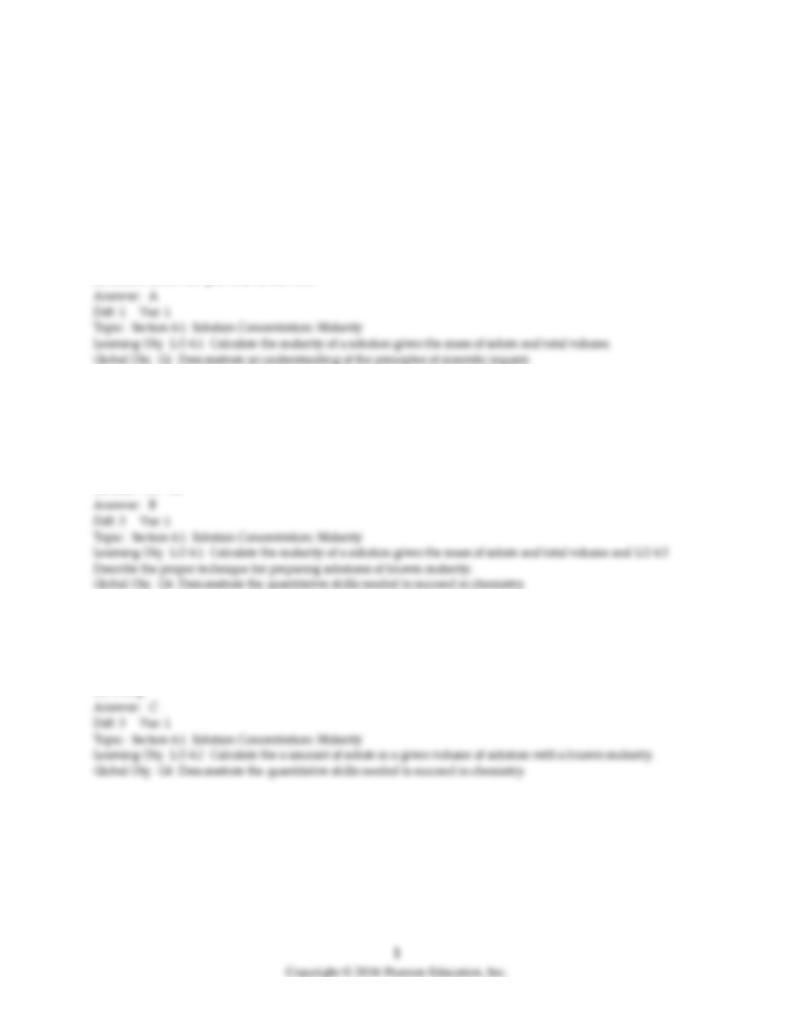
Chemistry, 7e (McMurry/Fay)
Chapter 4 Reactions in Aqueous Solutions
4.1 Multiple-Choice Questions
1) Molarity is defined as
A) moles of solute per liter of solution.
B) moles of solute per liter of solvent.
C) moles of solvent per liter of solution.
D) moles of solvent per liter of solvent.
2) What is the concentration of FeBr3 in a solution prepared by dissolving 10.0 g of FeBr3 in enough water
to make 275 mL of solution?
A) 1.23 × 10-4 M
B) 0.123 M
C) 1.23 M
D) 1.23 × 103 M
3) How many grams of KNO3 are needed to make 250. mL of a solution that is 0.135 M?
A) 1.71 g
B) 0.341 g
C) 3.41 g
D) 6.82 g

4) What volume of a 0.540 M KOH solution contains 15.5 g of KOH?
A) 0.54 L
B) 0.51 L
C) 1.95 L
D) 8.47 L
5) Which statement about diluted solutions is false? When a solution is diluted
A) the concentration of the solution decreases.
B) the molarity of the solution decreases.
C) the number of moles of solute remains unchanged.
D) the number of moles of solvent remains unchanged.
6) What is the concentration of HNO3 in the final solution when 70.0 mL of a 6.00 M HNO3 solution is
diluted with pure water to a total volume of 0.15 L?
A) 3.57 × 10-2 M
B) 2.80 M
C) 12.6 M
D) 1.75 M
7) How many milliliters of a 6.0 M HNO3 solution are needed to make 0.25 L of a 3.5 M HNO3 solution?
A) 686 mL
B) 428 mL
C) 146 mL
D) 119 mL
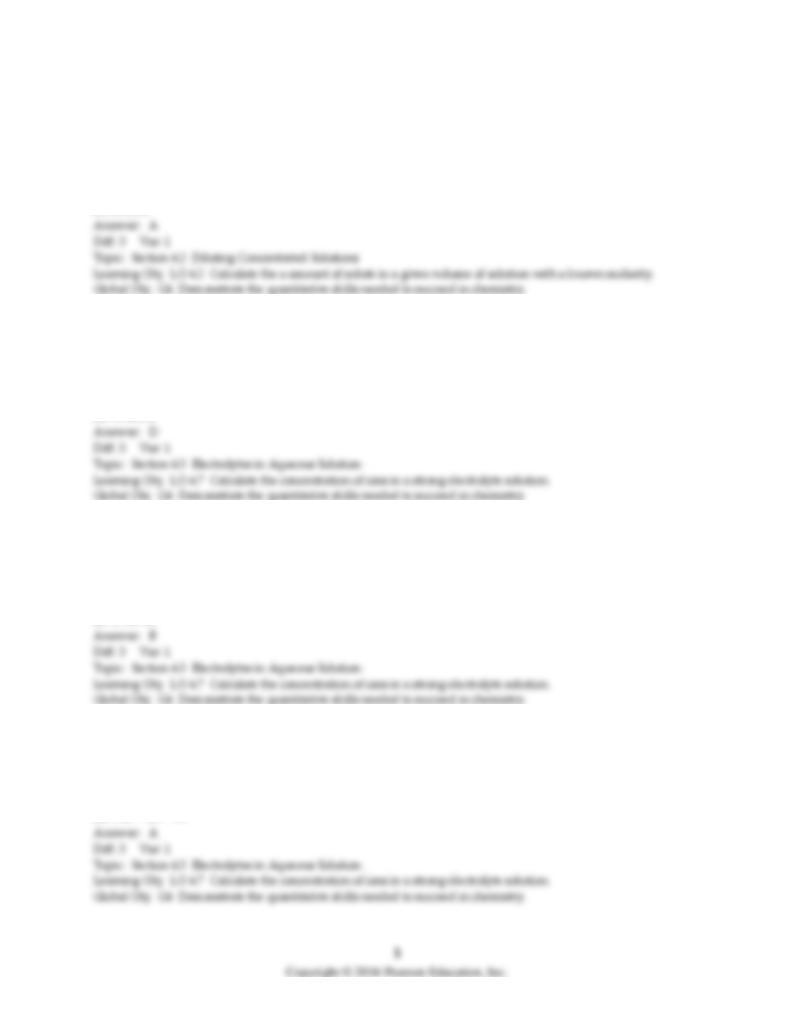
8) A student prepared a stock solution by dissolving 20.0 g of NaOH in enough water to make 150. mL of
solution. She then took 15.0 mL of the stock solution and diluted it with enough water to make 65.0 mL of
a final solution. What is the concentration of NaOH for the final solution?
A) 0.769 M
B) 0.548 M
C) 1.40 M
D) 1.82 M
9) What is the concentration of NO3- ions in a solution prepared by dissolving 15.0 g of Ba(NO3)2 in
enough water to produce 300. mL of solution?
A) 0.057 M
B) 0.191 M
C) 0.573M
D) 0.382 M
10) If the reaction of phosphate ion with water is ignored, what is the total concentration of ions in a
solution prepared by dissolving 3.00 g of Na3PO4 in enough water to make 350. mL of solution?
A) 0.0183 M
B) 0.209 M
C) 0.0523 M
D) 0.323 M
11) What is the concentration of an AlBr3 solution if 150. mL of the solution contains 250. mg of Br- ion?
A) 6.95 × 10-3 M
B) 2.08 × 10-2 M
C) 1.67 M
D) 6.23 × 10-3 M
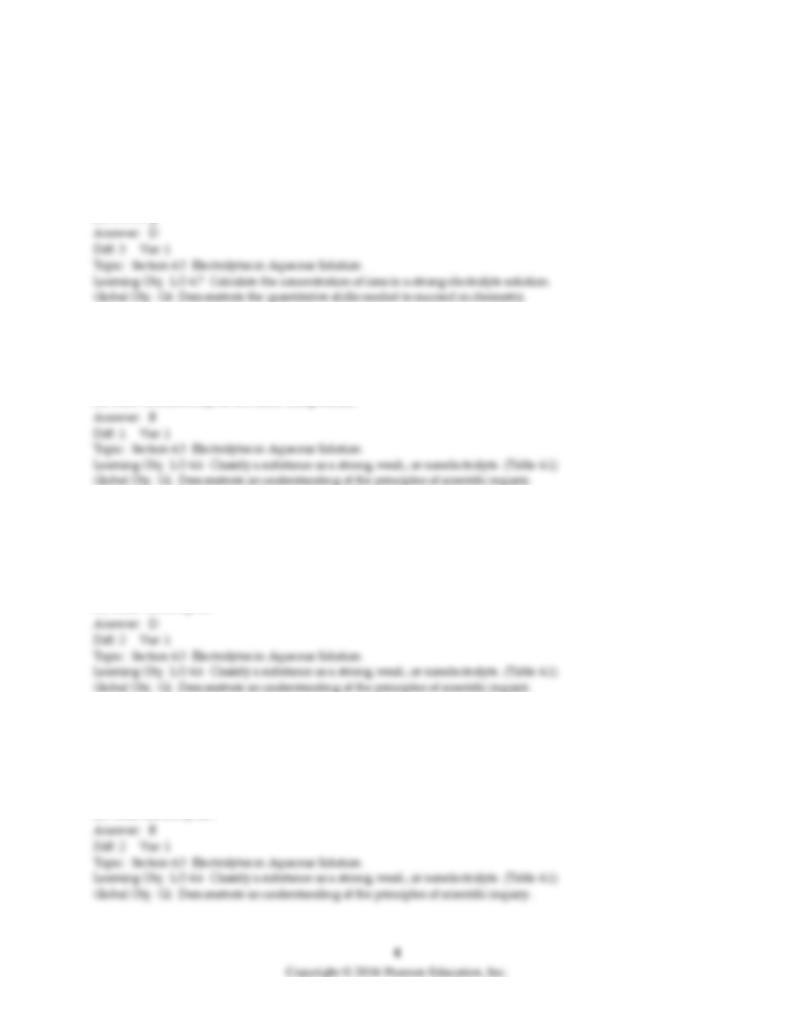
12) A student dissolved 3.00 g of Ca(NO3)2 in enough water to make 100. mL of stock solution. He took
4.00 mL of the solution then diluted it with water to give 275 mL of a final solution. How many grams of
NO3- ion are there in the final solution?
A) 0.329 g
B) 0.00073 g
C) 0.0453 g
D) 0.0906 g
13) Identify the statement that is true about nonelectrolytes.
A) Nonelectrolytes dissolve in water to produce ions.
B) Nonelectrolytes do not dissociate in water.
C) Nonelectrolytes conduct electricity.
D) Most nonelectrolytes are ionic compounds.
14) Acetic acid (CH3CO2H), formic acid (HCO2H), hydrofluoric acid (HF), ammonia (NH3), and
methylamine (CH3NH2) are commonly classified as
A) acids.
B) nonelectrolytes.
C) strong electrolytes.
D) weak electrolytes.
15) Water (H2O), methyl alcohol (CH3OH), ethyl alcohol (CH3CH2OH), ethylene glycol
(HOCH2CH2OH), and sucrose (C12H22O11) are commonly classified as
A) bases.
B) nonelectrolytes.
C) strong electrolytes.
D) weak electrolytes.

16) In a solution prepared by mixing CH3OH with H2O the major species present are
A) CH3OH and H2O.
B) CH3OH, H+, and OH-.
C) CH3+, OH-, and H2O.
D) CH3O-, H+, and H2O.
17) What is the molar concentration of sodium ions in a 0.350 M Na3PO4 solution?
A) 0.117 M
B) 0.350 M
C) 1.05 M
D) 1.40 M
18) The reaction 2 HNO3(aq) + Ba(OH)2(aq) → Ba(NO3)2(aq) + 2 H2O(l) is best classified as a(n)
A) acid-base neutralization reaction.
B) oxidation-reduction reaction.
C) precipitation reaction.
D) single replacement reaction.
19) The reaction Na3PO4(aq) + 3 AgNO3(aq) → Ag3PO4(s) + 3 NaNO3(aq) is best classified as a(n)
A) acid-base neutralization reaction.
B) oxidation-reduction reaction.
C) precipitation reaction.
D) single replacement reaction.
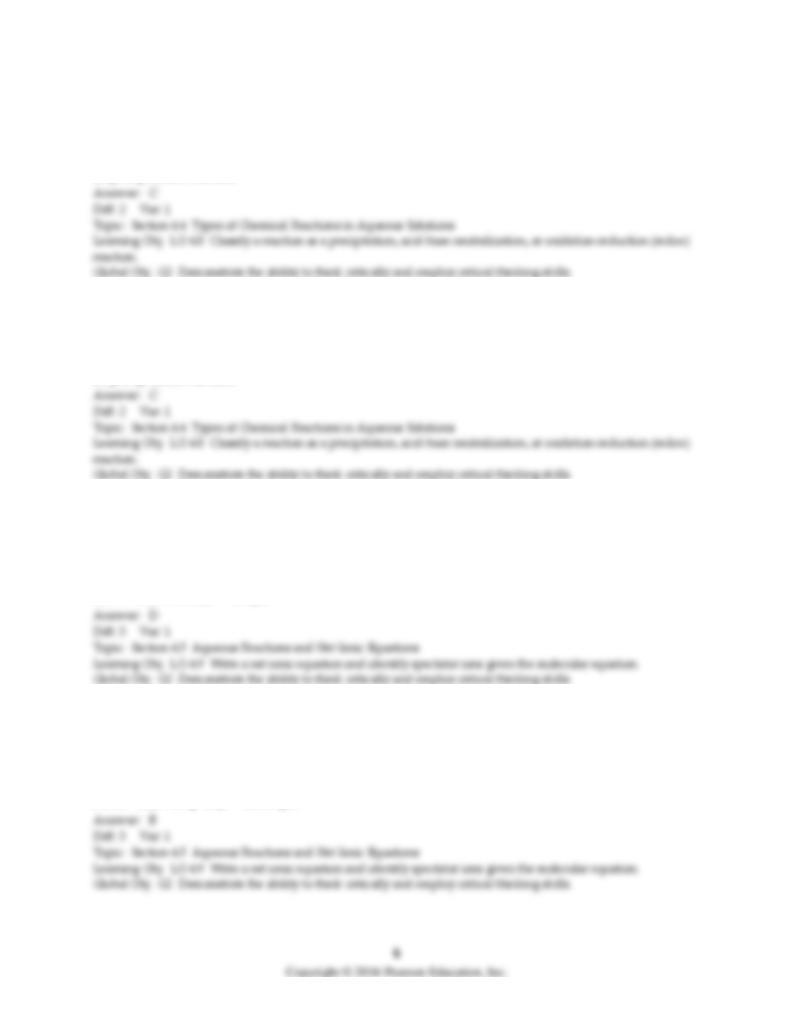
20) The reaction C6H12O6(s) + 6 O2(g) → 6 CO2(g) + 6 H2O(l) is best classified as a(n)
A) acid-base neutralization reaction.
B) double replacement reaction.
C) oxidation-reduction reaction.
D) precipitation reaction.
21) The combustion reaction CH4(g) + 2 O2(g) → CO2(g) + 2 H2O(l) can be classified as a(n)
A) acid-base neutralization reaction.
B) double replacement reaction.
C) oxidation-reduction reaction.
D) precipitation reaction.
22) Write a balanced net ionic equation for the reaction of Pb(NO3)2(aq) with NaI(aq).
A) Pb(NO3)2(aq) + 2 NaI(aq) → PbI2(s) + 2 NaNO3(aq)
B) Pb2+(aq) + 2 NO3-(aq) + 2 Na+(aq) + 2 I-(aq) → Pb2+(aq) + 2 I-(aq) + 2 Na+(aq) + 2 NO3-(aq)
C) Pb2+(aq) + 2 NO3-(aq) + 2 Na+(aq) + 2 I-(aq) → PbI2(s) + 2 Na+(aq) + 2 NO3-(aq)
D) Pb2+(aq) + 2 I-(aq) → PbI2(s)
23) Write a balanced net ionic equation for the reaction of H2SO4(aq) with Ba(OH)2(aq).
A) H2SO4(aq) + Ba(OH)2(aq) → BaSO4(s) + 2 H2O(l)
B) 2 H+(aq) + SO42-(aq) + Ba2+(aq) + 2 OH-(aq) → BaSO4(s) + 2 H2O(l)
C) H+(aq) + OH+(aq) → H2O(l)
D) Ba2+(aq) + SO42-(aq) → BaSO4(s)
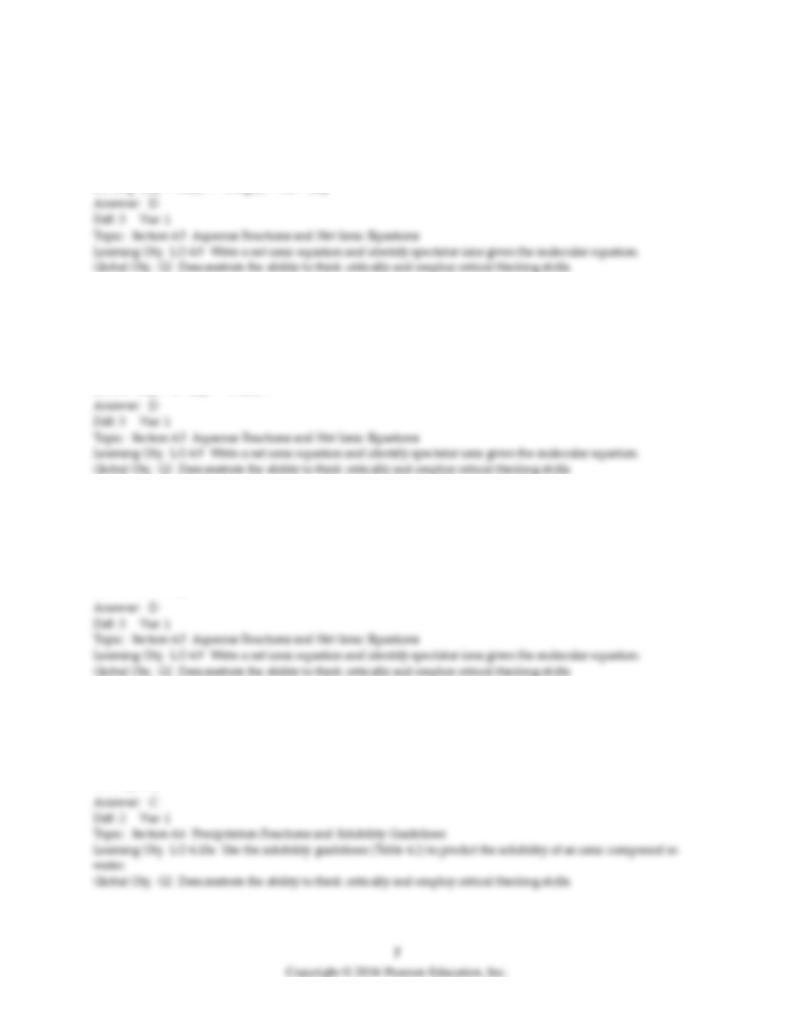
24) Write a balanced net ionic equation for the reaction of AgNO3(aq) with Cu(s).
A) AgNO3(aq) + Cu(s) → Ag(s) + CuNO3(aq)
B) Ag+(aq) + Cu(s) → Ag(s) + Cu+(aq)
C) 2 AgNO3(aq) + Cu(s) → 2 Ag(s) + CuNO3(aq)
D) 2Ag+(aq) + Cu(s) → 2 Ag(s) + Cu2+(aq)
25) Write a balanced net ionic equation for the reaction of NiBr2(aq) with (NH4)2S(aq).
A) NiBr2(aq) + (NH4)2S(aq) → NiS(s) + 2 NH4Br(aq)
B) Ni2+(aq) + 2 Br-(aq) + 2 NH4+(aq) + S2-(aq) → NiS(s) + 2 NH4+(aq) + 2 Br-(aq)
C) Ni2+(aq) + 2 Br-(aq) + 2 NH4+(aq) + S2-(aq) → NiS(s) + 2 NH4Br(s)
D) Ni2+(aq) + S2-(aq) → NiS(s)
26) In the reaction AgNO3(aq) + HI(aq) → AgI(s) + HNO3(aq) the spectator ions are
A) Ag+ and NO3-.
B) Ag+ and I-.
C) H+ and I-.
D) H+ and NO3-.
27) Which one of the following compounds is insoluble in water?
A) NH4SO4
B) Ba(OH)2
C) Ca3(PO4)2
D) Rb2CO3
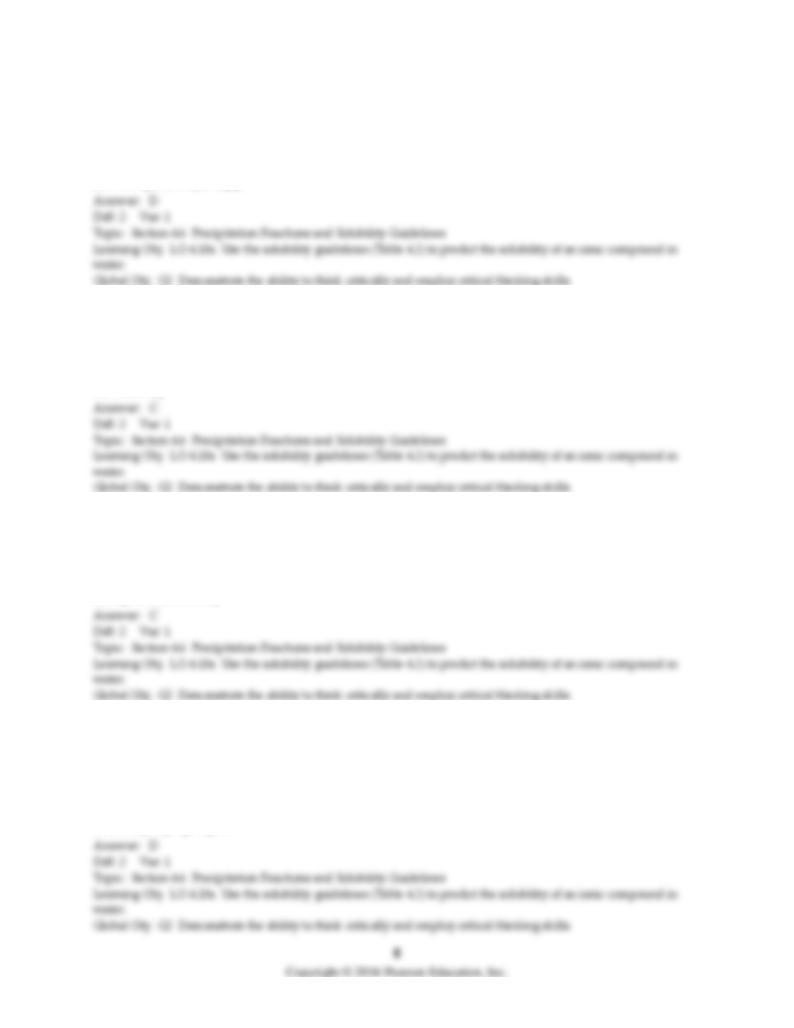
28) Which pair of compounds is insoluble in water?
A) AgNO3 and KNO3
B) Na2S and CuS
C) (NH4)2SO4 and AgI
D) PbSO4 and Pb3(PO4)2
29) Which one of the following compounds is soluble in water?
A) BaSO4
B) AgCl
C) Pb(ClO4)2
D) Ca(OH)2
30) Which pair of compounds is soluble in water?
A) AgCl and AgBr
B) CdS and (NH4)2S
C) KClO4 and Ba(ClO4)2
D) K2SO4 and BaSO4
31) Phthalic acid is a diprotic acid having the formula HO2CC6H4CO2H that can be converted to a salt
by reaction with base. Which of the following is expected to be most soluble in water?
A) HO2CC6H4CO2H
B) HO2CC6H4CO2Na
C) HO2CC6H4CO2K
D) NaO2CC6H4CO2Na
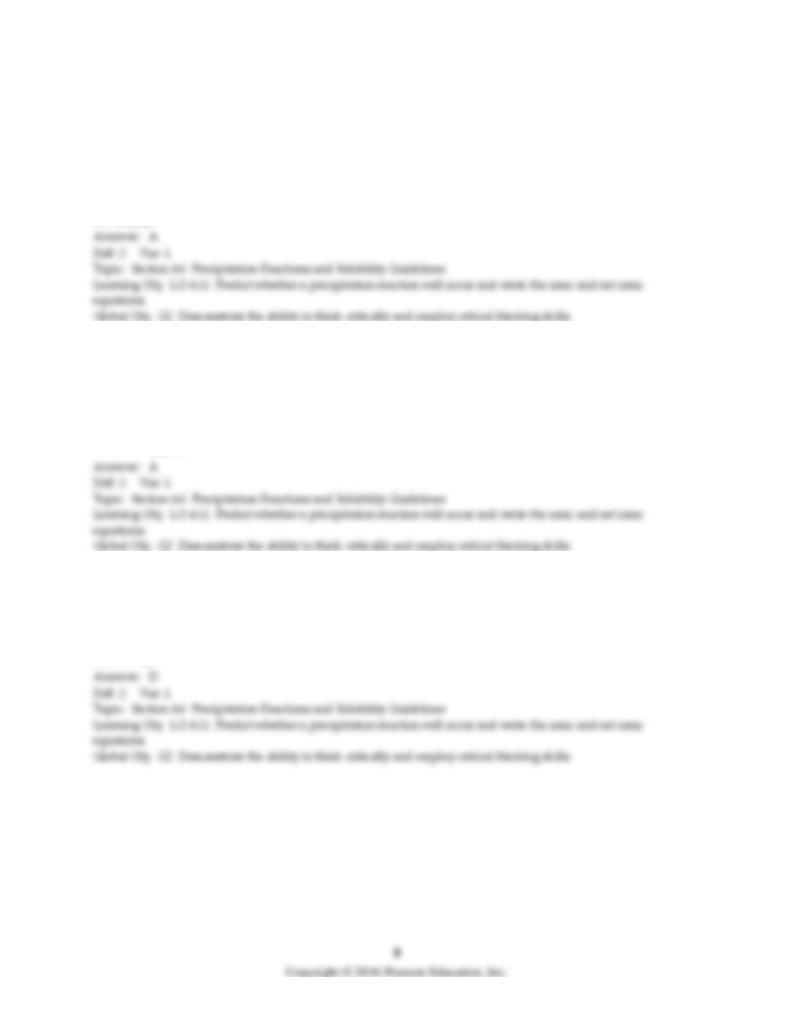
32) What reagent could be used to separate Br- from SO42- when added to an aqueous solution
containing both?
A) AgNO3(aq)
B) Ba(OH)2(aq)
C) CuSO4(aq)
D) NaI(aq)
33) What reagent could not be used to separate Cl- from S2- when added to an aqueous solution
containing both?
A) AgNO3(aq)
B) Ca(NO3)2(aq)
C) Cu(NO3)2(aq)
D) Fe(NO3)3(aq)
34) When K2SO4(aq) and Pb(NO3)2(aq) are mixed, a white colored precipitate forms which is
A) KNO3.
B) K2SO3.
C) Pb.
D) PbSO4.
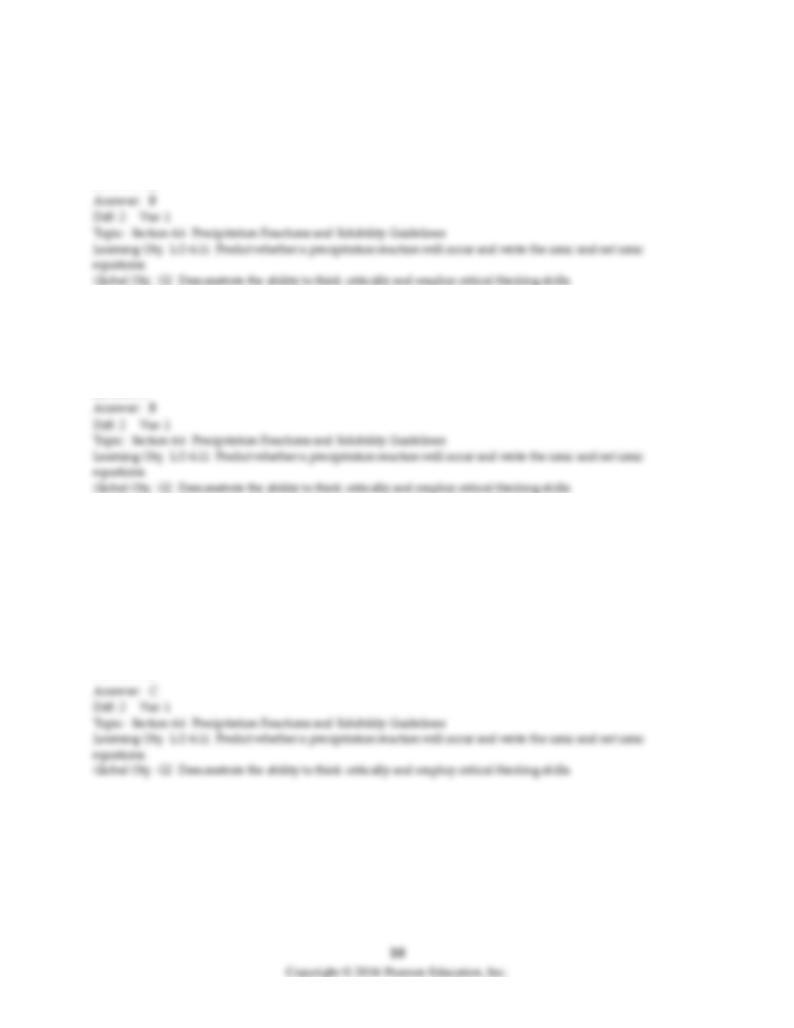
35) When Na2CrO4(aq) and AgNO3(aq) are mixed, a red colored precipitate forms which is
A) Ag.
B) Ag2CrO4.
C) AgNO2.
D) NaNO3.
36) What reagent would distinguish between Ag+ and Fe3+?
A) NaClO3
B) NaI
C) NaNO3
D) NaOH
37) When 50.0 mL of a 1.00 M solution of Fe(NO3)3 are mixed with 50.0 mL of a 1.00 M solution of NaOH,
a precipitate forms. What is the identity of the precipitate?
Fe(NO3)3(aq) + 3 NaOH(aq) → Fe(OH)3(s) + 3 NaNO3(aq)
A) Fe(NO3)3
B) NaOH
C) Fe(OH)3
D) NaNO3
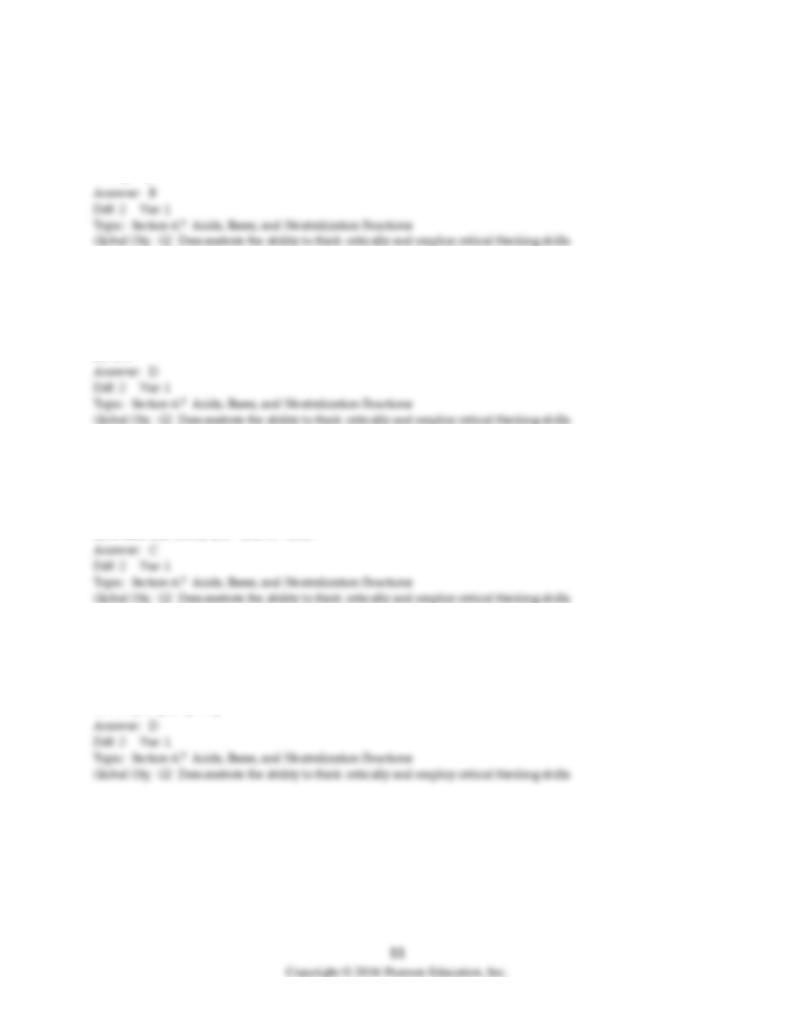
38) Which of the following compounds is not an Arrhenius acid?
A) HF
B) KOH
C) HClO
D) H2SO3
39) What ion is provided when Arrhenius bases dissolve in water?
A) H+
B) Na+
C) Cl-
D) OH-
40) When dissolved in water, LiOH behaves as
A) an acid that forms Li+ and OH- ions.
B) an acid that forms LiO- and H+ ions.
C) a base that forms Li+ and OH- ions.
D) a base that forms LiO- and H+ ions.
41) Which of the following compounds is an Arrhenius base in water?
A) C6H12O6
B) CH3COOH
C) KCl
D) NH2CH2CH2NH2
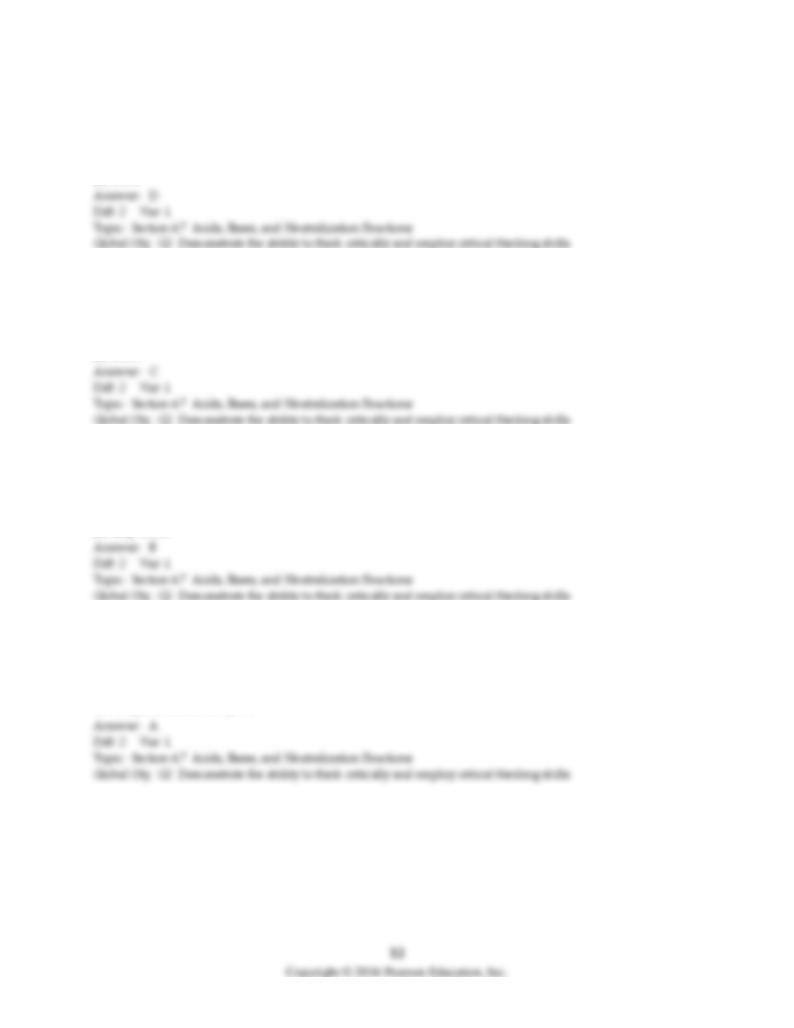
42) Which of the following compounds is an Arrhenius base in water?
A) CH3CH3
B) CH3SH
C) HOCl
D) KOH
43) Which one of the following compounds behaves as an acid when dissolved in water?
A) CH3OCH3
B) CH4
C) H2SO3
D) KOH
44) When dissolved in water, of HClO4, NH3, KOH, HI, and CH3OH which are acids?
A) NH3 and KOH
B) HClO4 and HI
C) only HI
D) only KOH
45) When dissolved in water, of HClO4, NH3, KOH, HI, and CH3OH which are bases?
A) NH3 and KOH
B) HClO4 and HI
C) only HI
D) NH3, KOH, and CH3OH
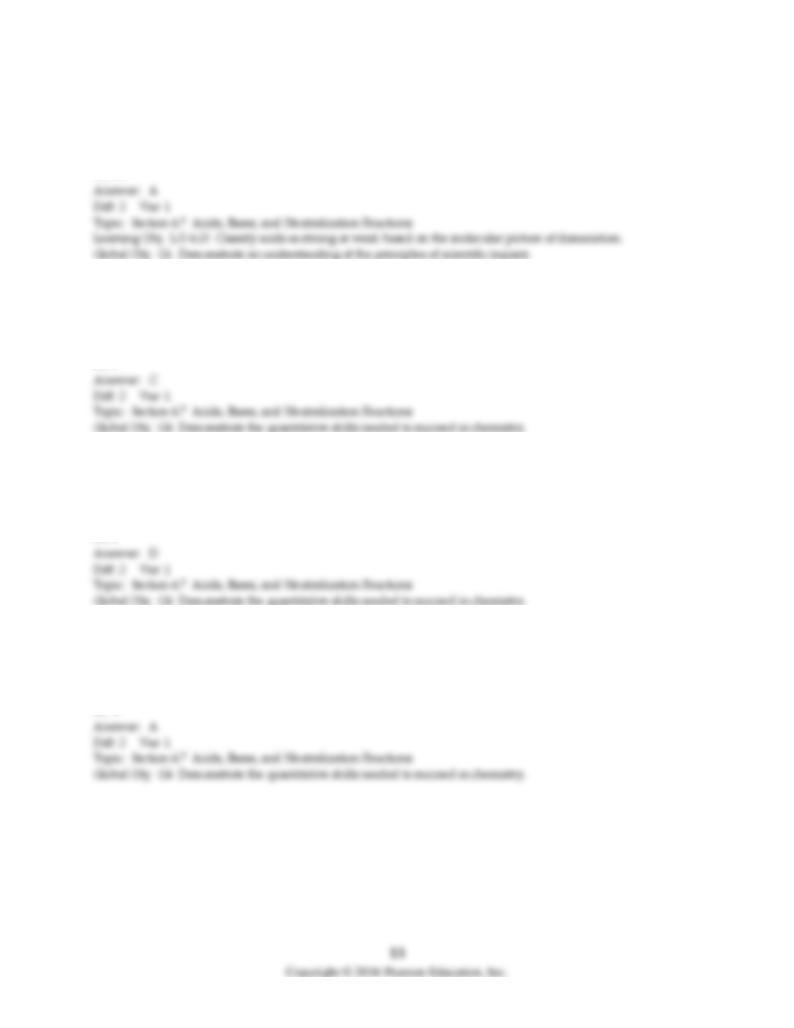
46) Which of the following is not a strong acid?
A) HF
B) HCl
C) HBr
D) HI
47) How many H+ ions can the acid, H2CO3, donate per molecule?
A) 0
B) 1
C) 2
D) 3
48) How many H+ ions can the acid H3PO4 donate per molecule?
A) 0
B) 1
C) 2
D) 3
49) How many H+ ions can the acid CH3CO2H donate per molecule?
A) 1
B) 2
C) 3
D) 4
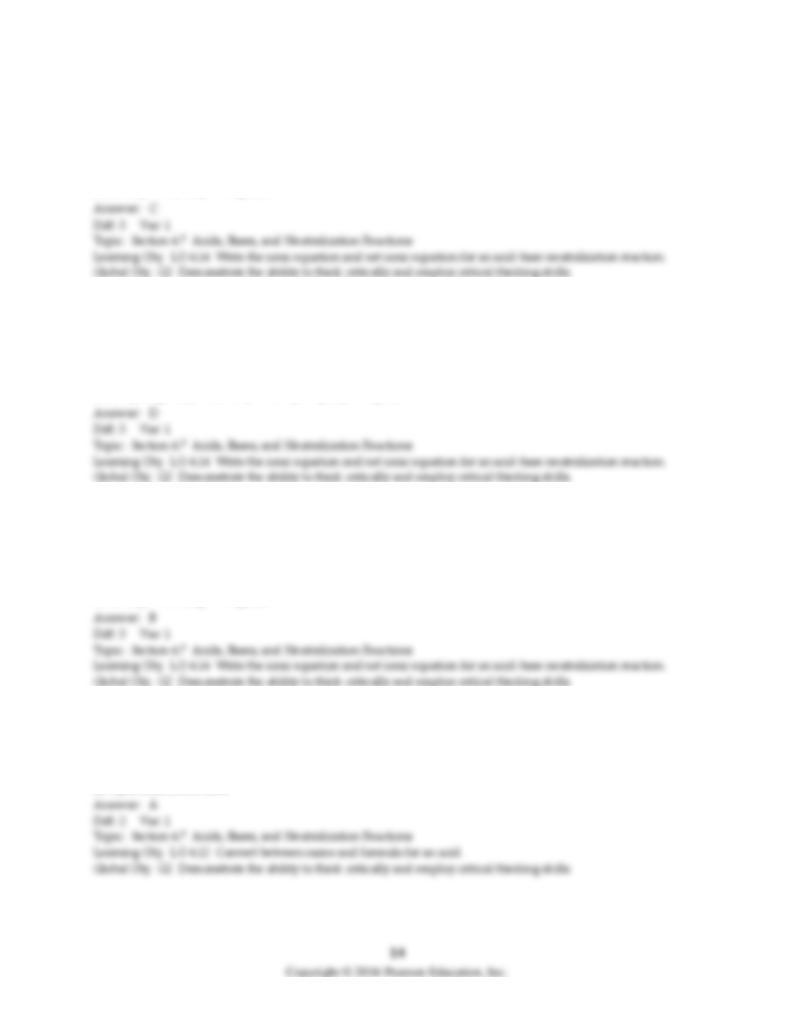
50) Write a net ionic equation for the neutralization reaction of HCN(aq) with NaOH(aq).
A) HCN(aq) + NaOH(aq) → NaCN(aq) + H2O(l)
B) HCN(aq) + Na+(aq) + OH-(aq) → Na+(aq) + CN-(aq) + H2O(l)
C) HCN(aq) + OH-(aq) → CN-(aq) + H2O(l)
D) H+(aq) + OH-(aq) → H2O(l)
51) Write a net ionic equation for the neutralization reaction of CH3CO2H(aq) with CsOH(aq).
A) CH3CO2H(aq) + CsOH(aq) → CH3CO2Cs(aq) + H2O(l)
B) CH3CO2-(aq) + H+(aq) + Cs+(aq) + OH-(aq) → CH3CO2-(aq) + Cs+ + H2O(l)
C) CH3CO2H(aq) + Cs+(aq) + OH-(aq) → CH3CO2Cs(s) + H2O(l)
D) CH3CO2H(aq) + OH-(aq) → CH3CO2-(aq) + H2O(l)
52) Write a net ionic equation for the neutralization reaction of H3PO4(aq) with Ba(OH)2(aq).
A) 2 H3PO4(aq) + 3 Ba(OH)2(aq) → Ba3(PO4)2(s) + 6 H2O(l)
B) 2 H3PO4(aq) + 3 Ba2+(aq) + 6 OH-(aq) → Ba3(PO4)2(s) + 6 H2O(l)
C) 6 H+(aq) + 2 PO43-(aq) + 3 Ba2+(aq) + 6 OH-(aq) → Ba3(PO4)2(s) + 6 H2O(l)
D) H+(aq) + OH-(aq) → H2O(l)
53) The name of H2SO3 is
A) sulfurous acid.
B) sulfuric acid.
C) hydrosulfuric acid.
D) hydrosulfurous acid.
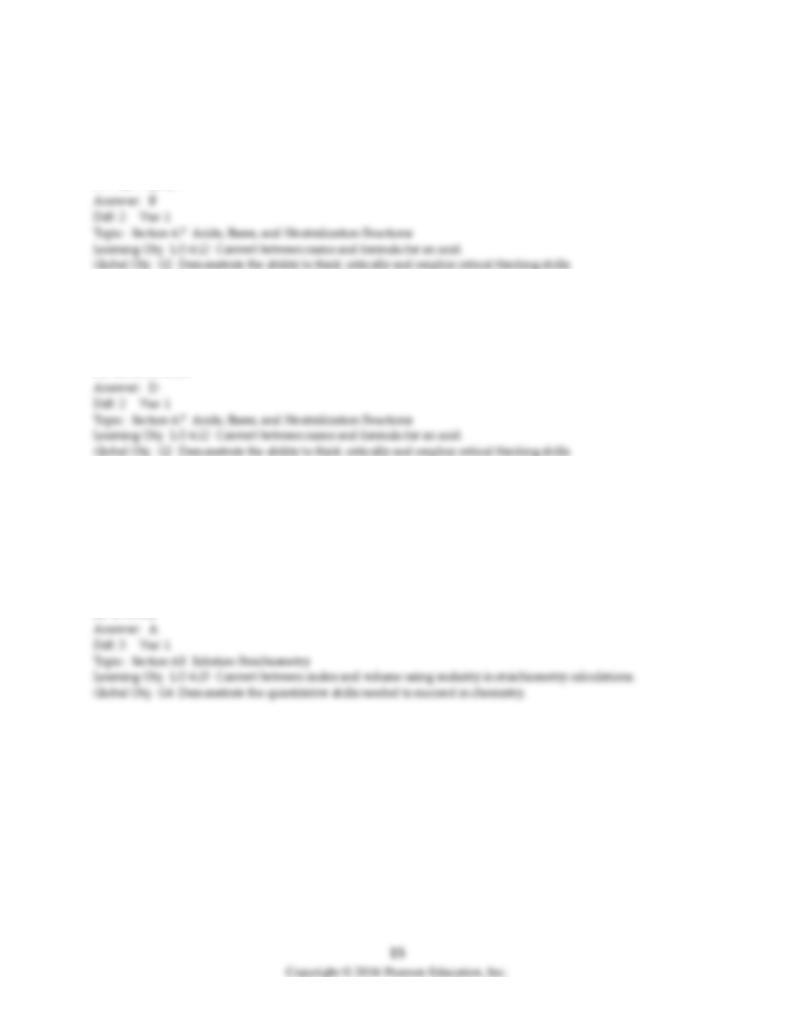
54) The chemical formula for nitric acid is
A) HNO2(aq).
B) HNO3(aq).
C) H2NO3(aq).
D) H2NO2(aq).
55) By analogy with the oxoacids of sulfur, H2TeO3 would be named
A) hydrotellurous acid.
B) pertelluric acid.
C) telluric acid.
D) tellurous acid.
56) How many milliliters of 0.300 M Li2S are needed to react with 25.00 mL of 0.315 M AgNO3?
Li2S(aq) + 2 AgNO3(aq) → 2 LiNO3(aq) + Ag2S(s)
A) 13.1 mL
B) 226.2 mL
C) 6.05 mL
D) 1.31 mL
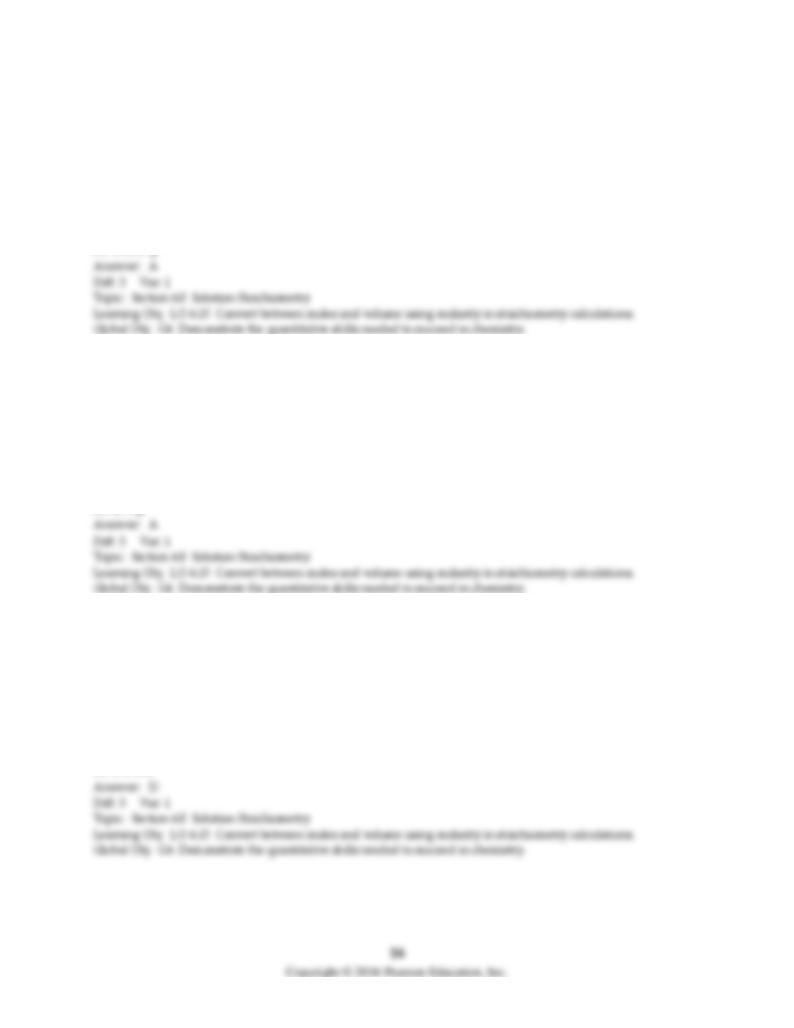
57) How many grams of BaCl2 are formed when 35.00 mL of 0.00237 M Ba(OH)2 reacts with excess Cl2
gas?
2 Ba(OH)2(aq) + 2 Cl2(g) → Ba(OCl)2(aq) + BaCl2(s) + 2 H2O(l)
A) 0.00864 g
B) 0.0173 g
C) 0.0346 g
D) 0.0829 g
58) When 125 mL of 0.500 M AgNO3 is added to 100. mL of 0.500 M NH4Cl, how many grams of AgCl
are formed?
AgNO3(aq) + NH4Cl(aq) → AgCl(s) + NH4NO3(aq)
A) 7.17 g
B) 8.96 g
C) 13.3 g
D) 25.8 g
59) How many milliliters of 0.100 M FeCl3 are needed to react with an excess of Na2S to produce 2.75 g of
Fe2S3 if the percent yield for the reaction is 65.0%?
3 Na2S(aq) + 2 FeCl3(aq) → Fe2S3(s) + 6 NaCl(aq)
A) 25.4 mL
B) 43.0 mL
C) 50.1 mL
D) 102 mL
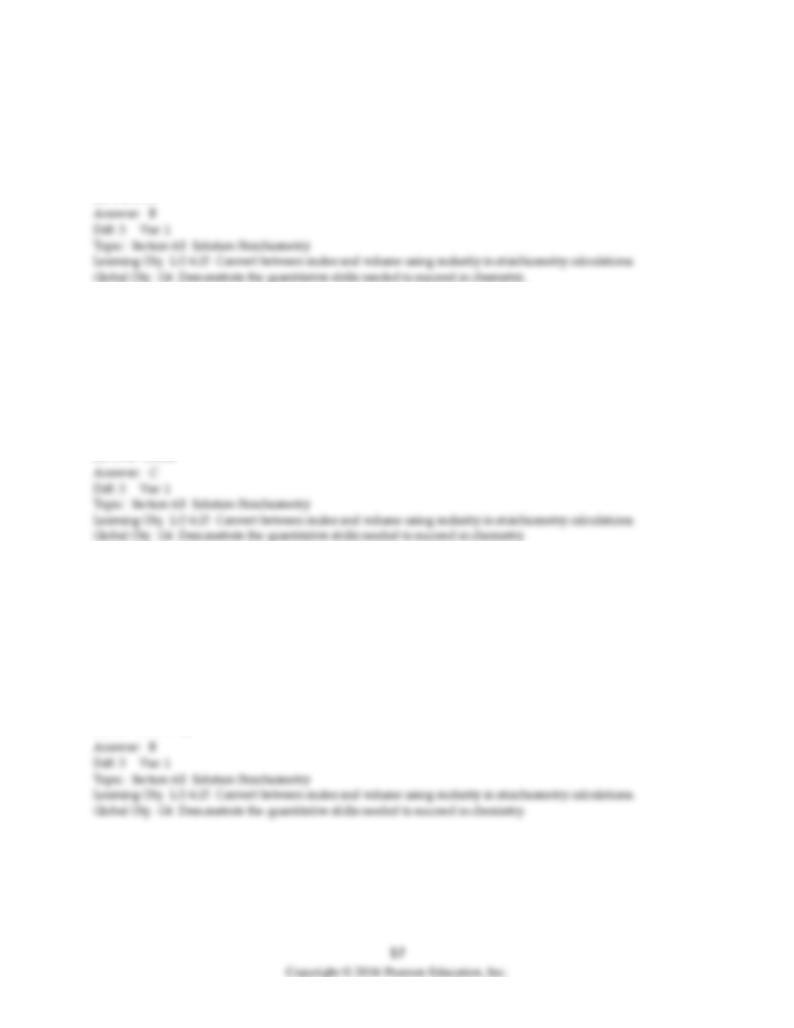
60) If 200. mL of 0.100 M Na2SO4 is added to 200. mL of 0.150 M NaCl, what is the concentration of Na+
ions in the final solution? Assume that the volumes are additive.
A) 0.05 M
B) 0.175 M
C) 0.125 M
D) 0.250 M
61) When 50.0 mL of a 1.00 M solution of Fe(NO3)3 are mixed with 50.0 mL of a 1.00 M solution of NaOH,
a precipitate forms. How many moles of precipitate is formed?
Fe(NO3)3(aq) + 3 NaOH(aq) → Fe(OH)3(s) + 3 NaNO3(aq)
A) 0.33 moles
B) 1.00 mole
C) 0.05 moles
D) 0.017 moles
62) When 50.0 mL of a 1.00M solution of Fe(NO3)3 are mixed with 50.0mL of a 1.00 M solution of NaOH,
a precipitate forms. What ions remain after the reaction is complete?
Fe(NO3)3(aq) + 3 NaOH(aq) → Fe(OH)3(s) + 3 NaNO3(aq)
A) Fe3+ and OH-
B) Fe3+, Na+, and OH-
C) Fe3+, OH-, Na+, and NO3-
D) Na+ and NO3-

63) What is the oxidation number of the sulfur atom in S8?
A) -2
B) 0
C) +6
D) +8
64) What is the oxidation number of the chromium atom in K2Cr2O4?
A) -2
B) +3
C) +6
D) +7
65) What is the oxidation number of the sulfur atom in SO2?
A) -2
B) +2
C) -4
D) +4
66) What is the oxidation number change for the manganese atom in the following unbalanced reduction
half reaction?
MnO4-(aq) + H+(aq) → Mn2+(aq) + H2O(l)
A) -7
B) -5
C) +5
D) +7
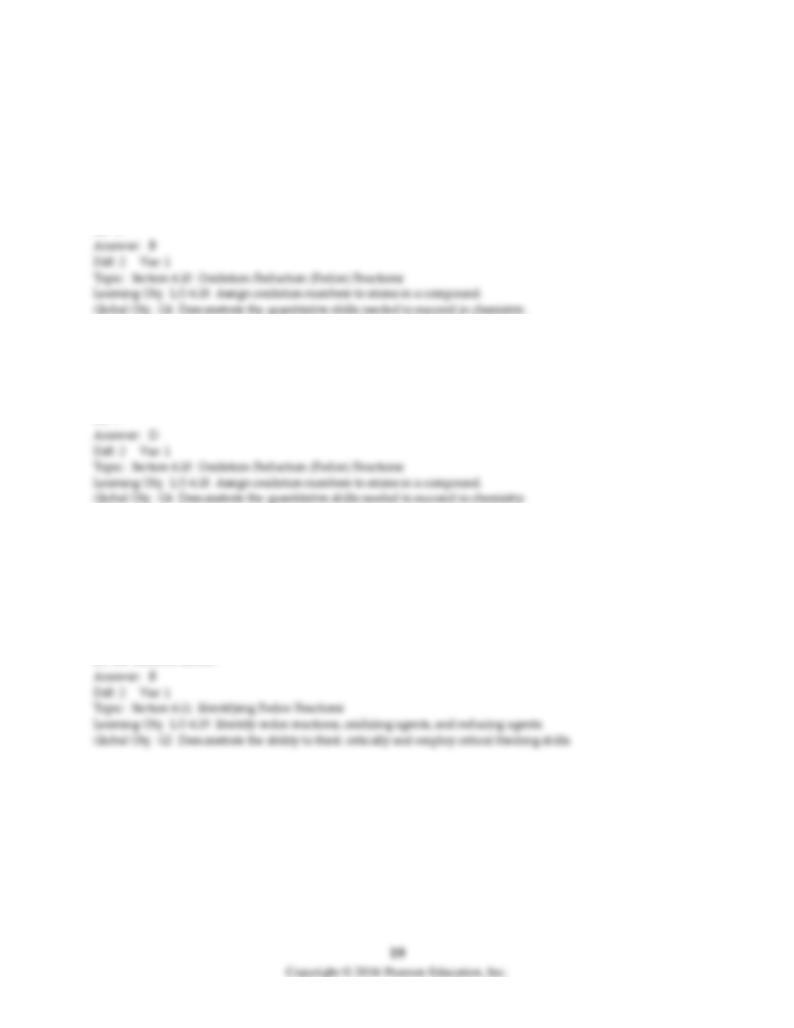
67) What is the oxidation number change for the iron atom in the following reaction?
2 Fe2O3(s) + 3 C(s) → 4 Fe(s) + 3 CO2(g)
A) -6
B) -3
C) +3
D) +6
68) The oxidation state of chlorine in ClO4- is
A) 0
B) +5
C) -5
D) +7
69) In the following reaction, Cl2 is
2 Rb(s) + Cl2(g) → 2 RbCl(s)
A) the reducing agent.
B) the oxidizing agent.
C) oxidized.
D) the electron donor.
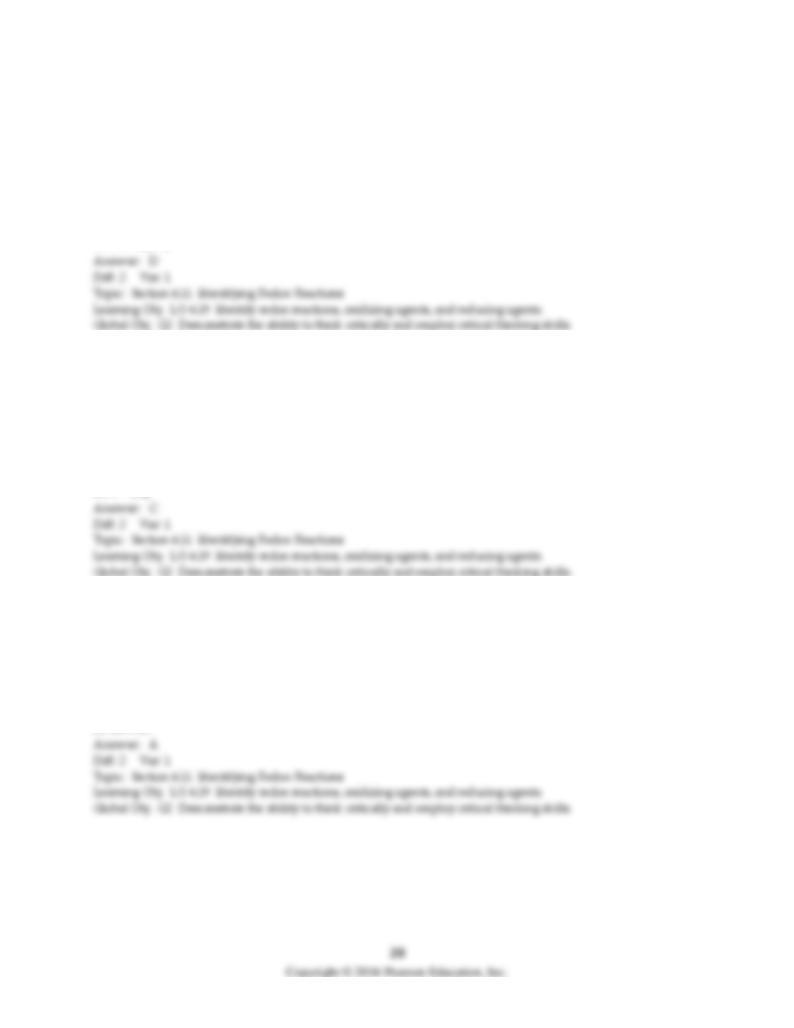
70) Which species functions as the oxidizing agent in the following reduction-oxidation reaction?
5 Fe2+(aq) + MnO4-(aq) + 8 H+(aq) → Mn2+(aq) + 5 Fe3+(aq) + 4 H2O(l)
A) Fe2+(aq)
B) H+(aq)
C) Mn2+(aq)
D) MnO4-(aq)
71) Which species functions as the reducing agent in the following reduction-oxidation reaction?
2 P(s) + 3 Br2(l) → 2 PBr3(l)
A) Br-(aq)
B) Br2(l)
C) P(s)
D) P3+(aq)
72) Which species functions as the reducing agent in the following reduction-oxidation reaction?
ZnO(s) + C(s) → Zn(s) + CO(g)
A) C(s)
B) CO(g)
C) Zn(s)
D) ZnO(s)
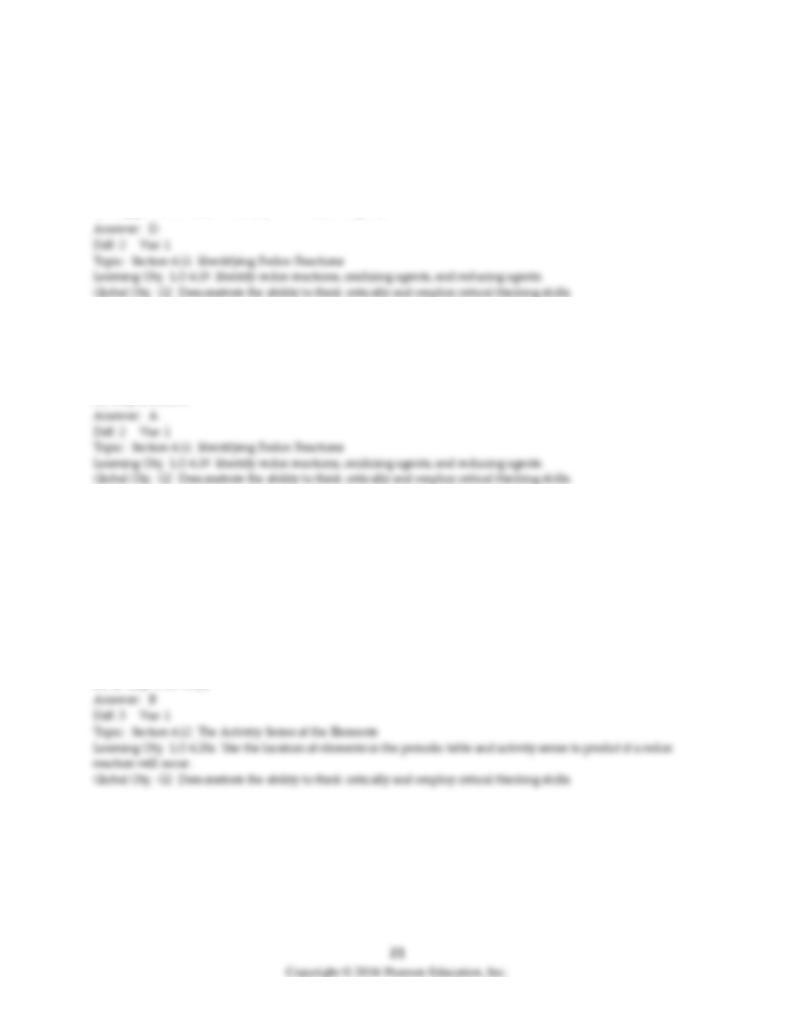
73) Disproportionation is a reaction in which a substance is both oxidized and reduced in the reaction.
Which is a disproportionation reaction?
A) ClO3-(aq) + 3 Cu(s) + 6 H+(aq) → Cl-(aq) + 3 Cu2+(aq) + 3 H2O(l)
B) ClO-(aq) + Pb(OH)4-(aq) → Cl-(aq) + PbO2(s) + H2O(l) + 2 OH-(aq)
C) 6 Cl-(aq) + Cr2O72-(aq) + 14 H+(aq) → 3 Cl2(g) + 2 Cr3+(aq) + 7 H2O(l)
D) Cl2(g) + 2 OH-(aq) → Cl-(aq) + ClO-(aq) + H2O(l)
74) In the reaction 2 H2O2(l) → 2 H2O(l) + O2(g) oxygen is
A) both oxidized and reduced.
B) neither oxidized nor reduced.
C) only oxidized.
D) only reduced.
75) Using the following portion of the activity series for oxidation half-reactions, determine which
combination of reactants will result in a reaction.
Li(s) → Al3+(aq) + e-
Cr(s) → Al3+(aq) + 3e-
A) Li(s) with Al(s)
B) Li(s) with Al3+(aq)
C) Li+(aq) with Al3+(aq)
D) Li+(aq) with Al(s)
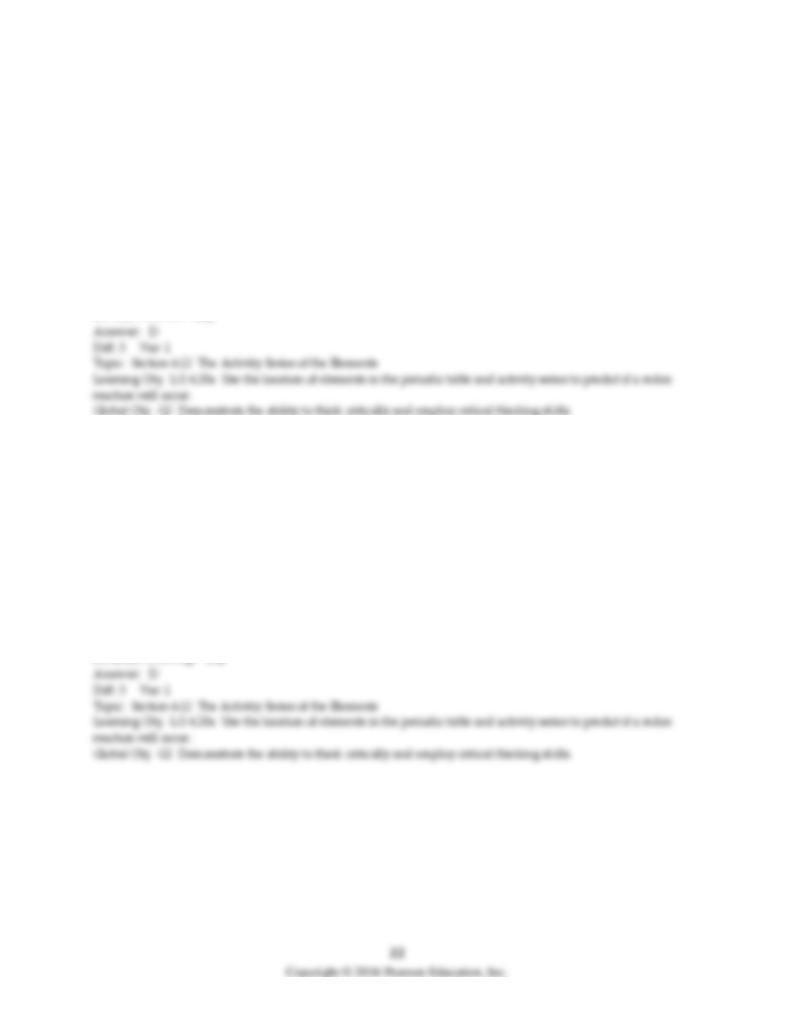
76) Using the following portion of the activity series for oxidation half reactions
K(s) → K+(aq) + e-
Al(s) → Al3+(aq) + 3e-
Fe(s) → Fe2+(aq) + 2e-
Sn(s) → Sn2+(aq) + 2e-
determine which reaction will occur.
A) Al3+(aq) with Fe(s)
B) Al(s) with Sn(s)
C) K+(aq) with Fe2+(aq)
D) K(s) with Sn2+(aq)
77) Using the following portion of the activity series for oxidation half reactions
Ca(s) → Ca2+(aq) + 2e-
Mg(s) → Mg2+(aq) + 2e-
Zn(s) → Zn2+(aq) + 2e-
Cu(s) → Cu2+(aq) + 2e-
determine which reaction will not occur.
A) Ca(s) with Cu2+(aq)
B) Ca(s) with Zn2+(aq)
C) Zn(s) with Cu2+(aq)
D) Zn(s) with Mg2+(aq)
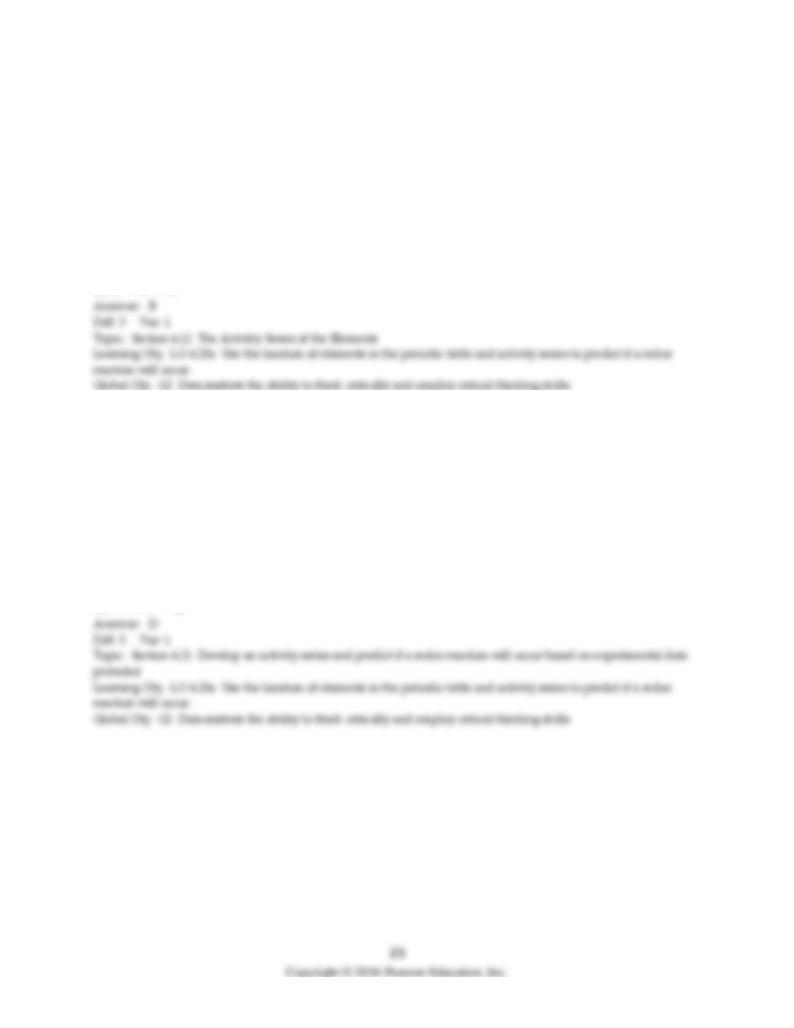
78) Using the following sequence of reactions, determine the order of reducing agents (strongest to
weakest).
A + B+ → A+ + B
A + C+ → A+ + C
B + C+ → no reaction
A) A > B > C
B) A > C > B
C) B > C > A
D) C+ > B+ > A+
79) Using the following sequence of reactions, determine the order of oxidizing agents (strongest to
weakest).
Q + U+ → Q+ + U
U + W+ → U+ + W
Q + W+ → Q+ + W
A) Q > U > W
B) W > U > Q
C) Q+ > U+ > W+
D) W+ > U+ > Q+
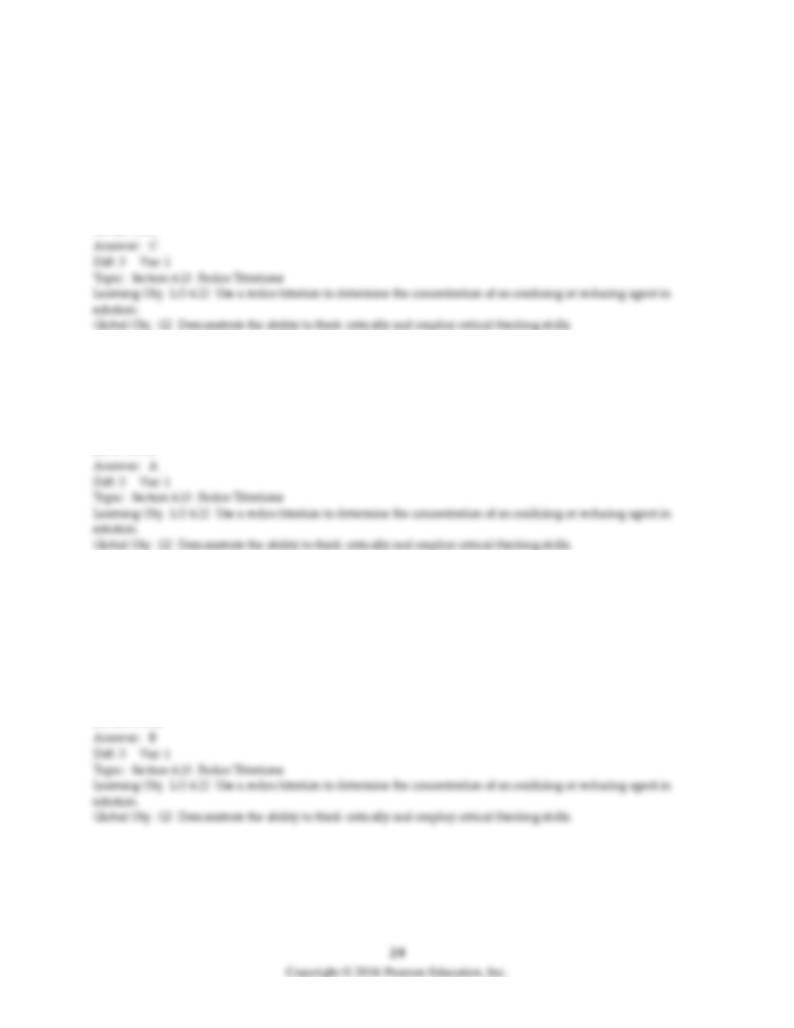
80) How many milliliters of 0.550 M hydriodic acid are needed to react with 25.00 mL of 0.330 M CsOH?
HI(aq) + CsOH(aq) → CsI(aq) + H2O(l)
A) 0.133 mL
B) 0.0667 mL
C) 15.0 mL
D) 41.7 mL
81) In an acid-base neutralization reaction 23.74 mL of 0.400 M sodium hydroxide reacts with 50.00 mL of
sulfuric acid solution. What is the concentration of the H2SO4 solution?
A) 0.0950 M
B) 0.190 M
C) 0.380 M
D) 0.760 M
82) Balance the chemical equation given below, and determine the number of milliliters of 0.0600 M
phosphoric acid required to neutralize 25.00 mL of 0.0150 M calcium hydroxide.
________ Ca(OH)2(aq) + ________ H3PO4(aq) → ________ Ca3(PO4)2(s) + ________ H2O(l)
A) 1.69 mL
B) 4.17 mL
C) 6.25 mL
D) 12.50 mL
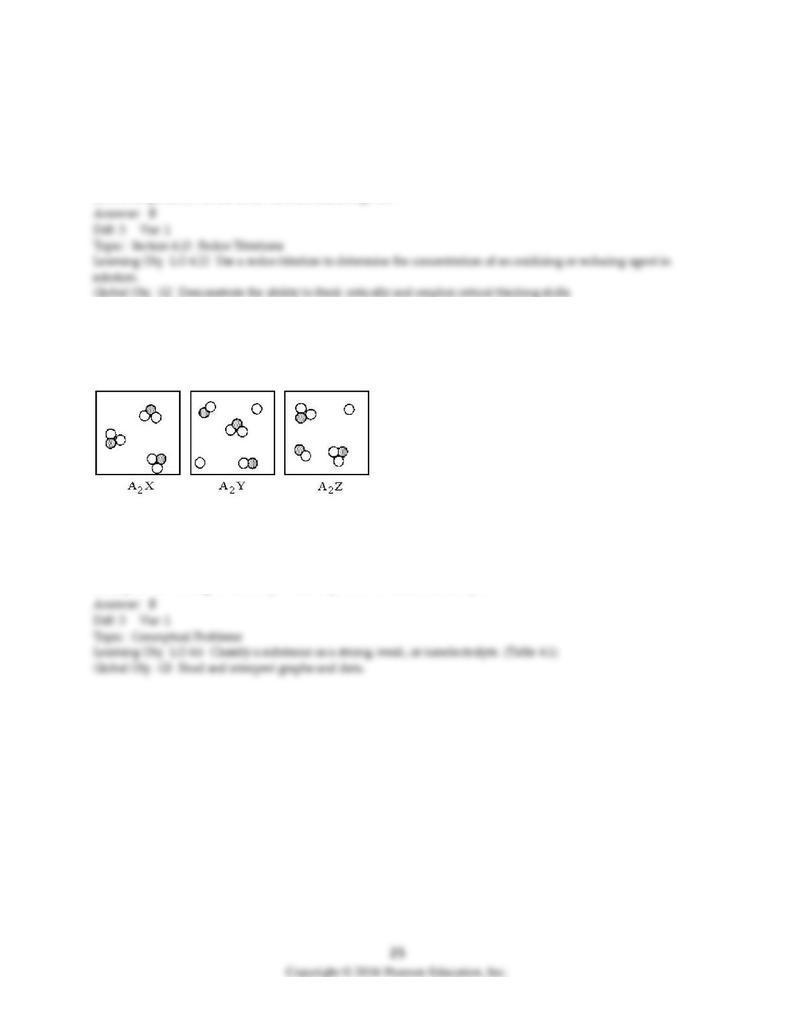
83) When 200. mL of 1.50 × 10-4 M hydrochloric acid is added to 100. mL of 1.75 × 10-4 M Mg(OH)2, the
resulting solution will be
A) acidic.
B) basic.
C) neutral.
D) It is impossible to tell from the information given.
84) Three different substances, A2X, A2Y, and A2Z, were dissolved in water with the following results.
(Water molecules are omitted for clarity.) Which of the substances is the strongest electrolyte, and which
is the weakest?
A) A2X is the strongest electrolyte and A2Y is the weakest electrolyte.
B) A2Y is the strongest electrolyte and A2X is the weakest electrolyte.
C) A2Y is the strongest electrolyte and A2Z is the weakest electrolyte.
D) A2Z is the strongest electrolyte and A2Y is the weakest electrolyte.
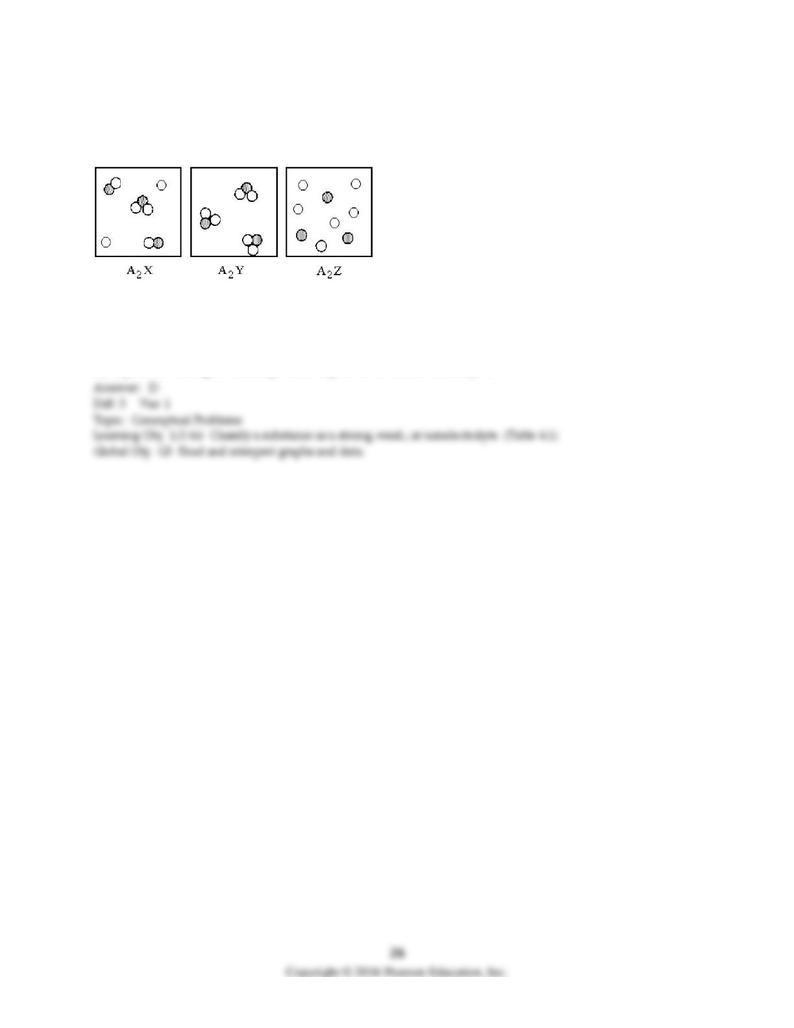
85) Three different substances, A2X, A2Y, and A2Z, were dissolved in water with the following results.
(Water molecules are omitted for clarity.) Which of the substances is the strongest electrolyte, and which
is the weakest?
A) A2X is the strongest electrolyte and A2Y is the weakest electrolyte.
B) A2Y is the strongest electrolyte and A2X is the weakest electrolyte.
C) A2Y is the strongest electrolyte and A2Z is the weakest electrolyte.
D) A2Z is the strongest electrolyte and A2Y is the weakest electrolyte.
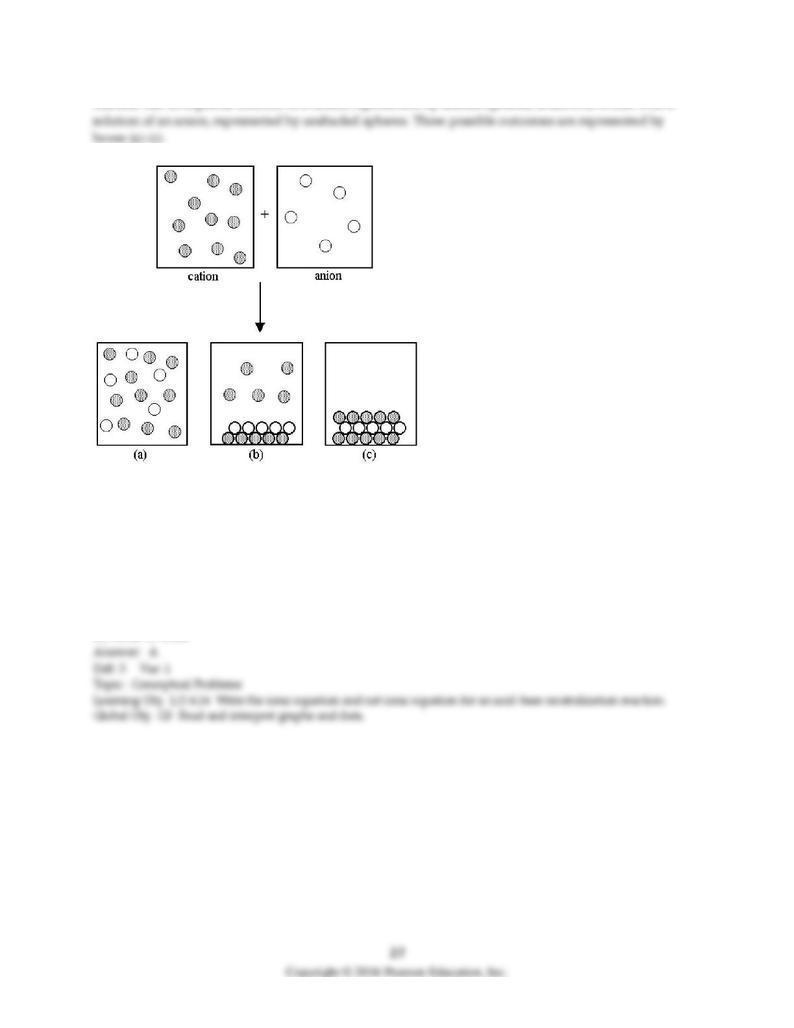
Assume that an aqueous solution of a cation, represented by shaded spheres, is allowed to mix with a
86) Which outcome corresponds to the mixing of potassium and sulfide ions shown in the following
equation?
2 K+(aq) + S2-(aq) → ?
A) box (a)
B) box (b)
C) box (c)
D) None of these
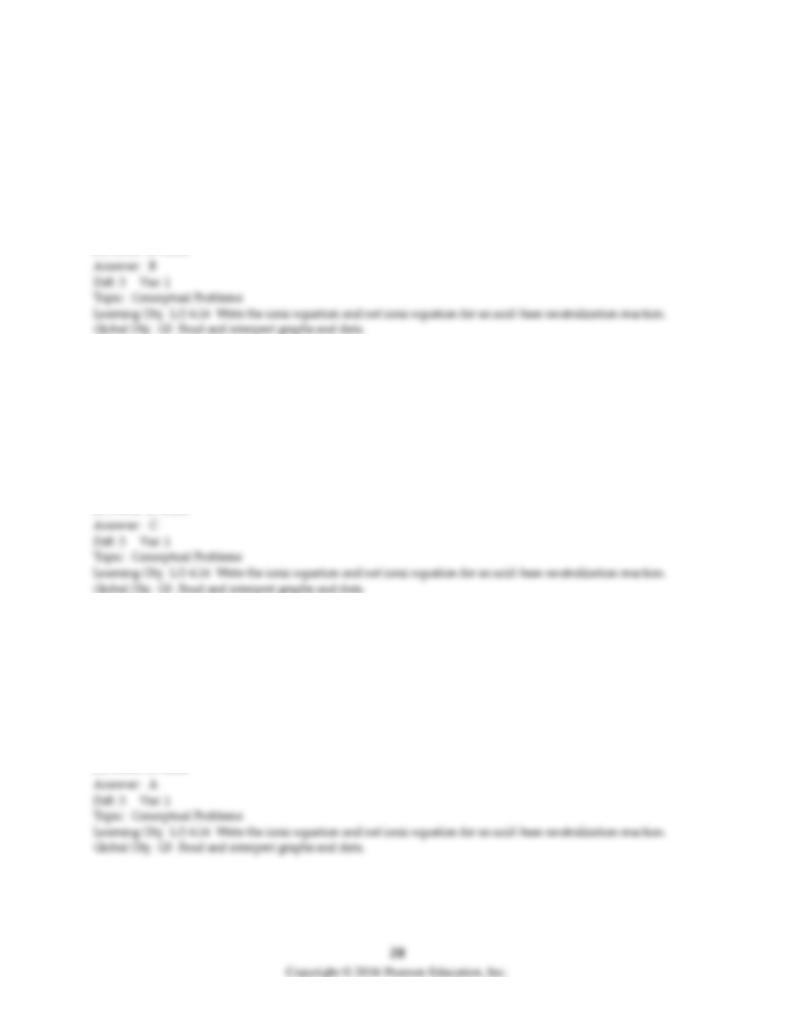
87) Which outcome corresponds to the combination of calcium and carbonate ions shown in the following
equation?
Ca2+(aq) + CO32-(aq) → ?
A) box (a)
B) box (b)
C) box (c)
D) None of these
88) Which outcome corresponds to the combination of silver and chromate ions shown in the following
equation?
Ag+(aq) + CrO42-(aq) → ?
A) box (a)
B) box (b)
C) box (c)
D) None of these
89) Which outcome corresponds to the mixing of sodium and sulfate ions shown in the following
equation?
2 Na+(aq) + SO42-(aq) → ?
A) box (a)
B) box (b)
C) box (c)
D) None of these
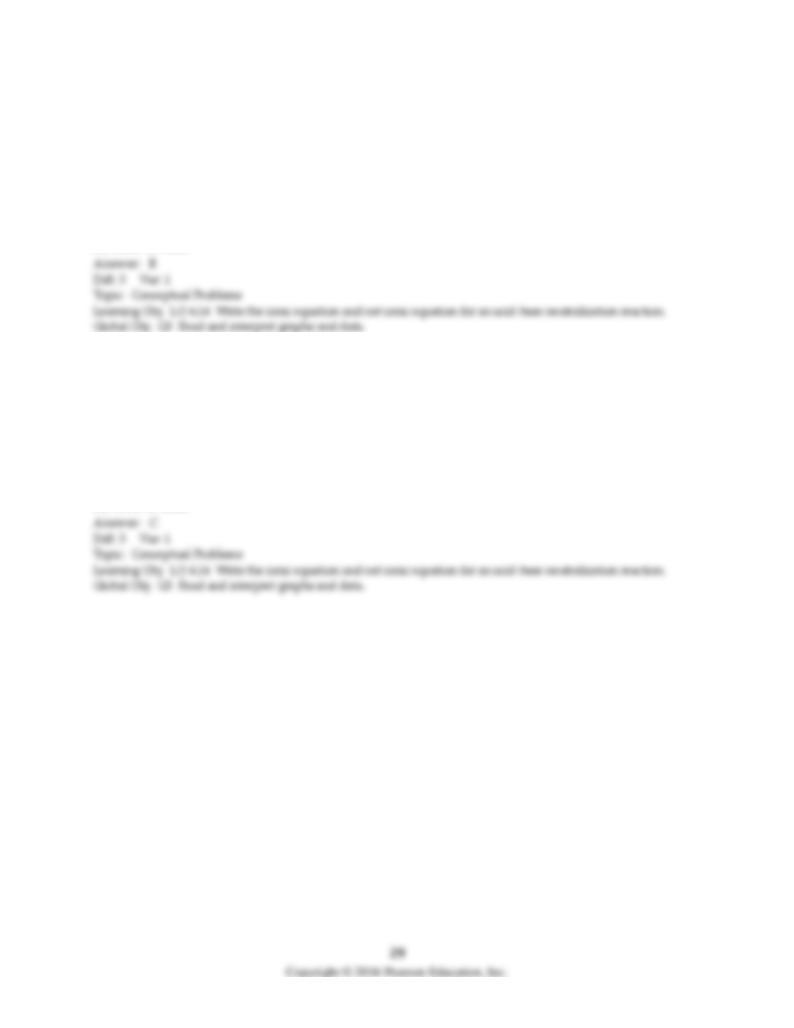
90) Which outcome corresponds to the combination of copper(II) and sulfide ions shown in the following
equation?
Cu2+(aq) + S2-(aq) → ?
A) box (a)
B) box (b)
C) box (c)
D) None of these
91) Which outcome corresponds to the combination of silver and carbonate ions shown in the following
equation?
Ag+(aq) + CO32-(aq) → ?
A) box (a)
B) box (b)
C) box (c)
D) None of these
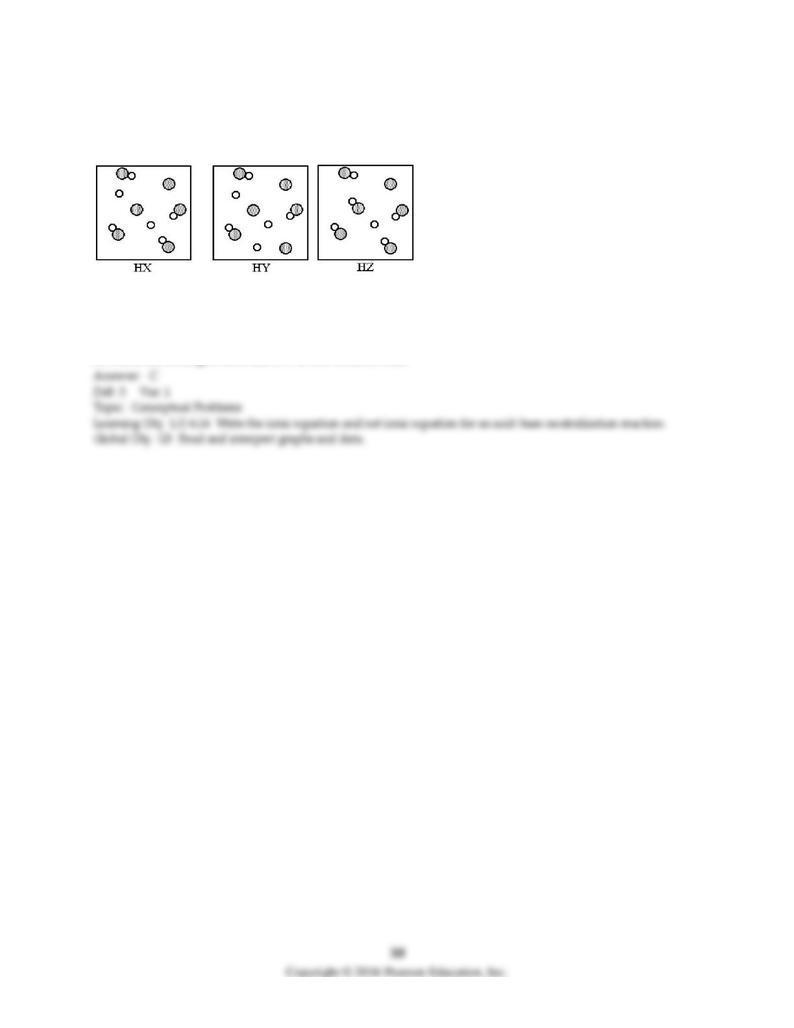
92) The following pictures represent aqueous solutions of three acids HA (A = X, Y, or Z), with water
molecules omitted for clarity. Unshaded spheres represent hydrogen atoms or ions and gray spheres
represent A atoms or ions. Which of the three is the strongest acid, and which is the weakest?
A) HX is the strongest acid and HY is the weakest acid.
B) HY is the strongest acid and HX is the weakest acid.
C) HY is the strongest acid and HZ is the weakest acid.
D) HZ is the strongest acid and HY is the weakest acid.
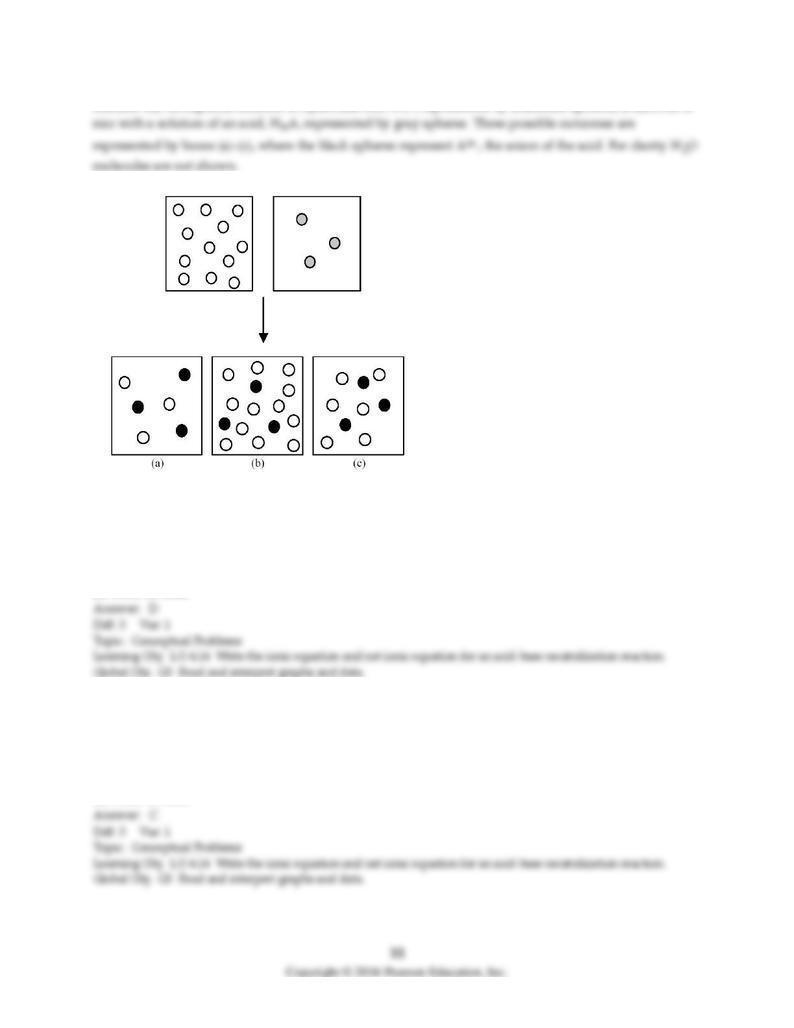
Assume that an aqueous solution of hydroxide ion, OH-, represented by unshaded spheres, is allowed to
93) Which outcome corresponds to the reaction:
HCN + OH- → H2O + CN-?
A) box (a)
B) box (b)
C) box (c)
D) None of these
94) Which outcome corresponds to the reaction:
H2SO4 + 2 OH- → 2 H2O + SO42-?
A) box (a)
B) box (b)
C) box (c)
D) None of these
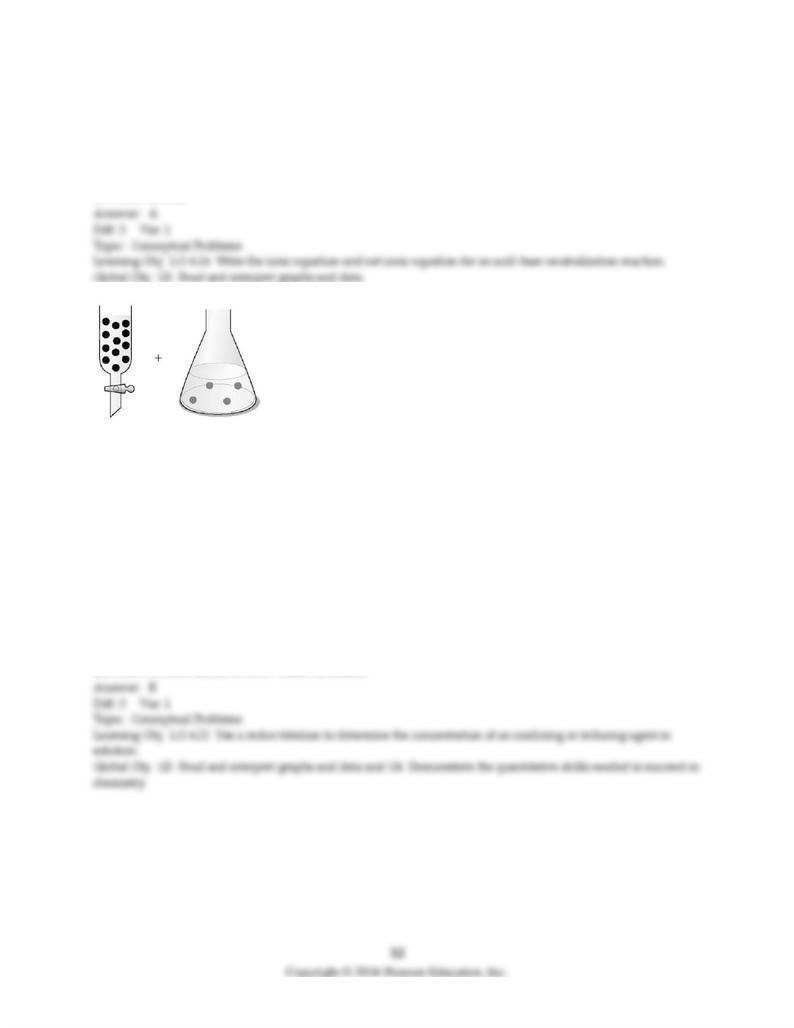
95) Which outcome corresponds to the reaction:
H3AsO4 + 3 OH- → 3 H2O + AsO43-?
A) box (a)
B) box (b)
C) box (c)
D) None of these
96) The concentration of an aqueous solution of NaOCl can be determined by a redox titration with
iodide ion in acidic solution:
OCl- (aq) + 2 I- (aq) + 2 H⁺ (aq) → Cl⁻ (aq) + I2 (aq) + H2O (l)
Assume that the black spheres in the buret represent I⁻ ions, the gray spheres in the flask represent OCl⁻
ions, the concentration of the I⁻ ions in the buret is 0.120 M, and the volumes in the buret and the flask are
identical. What is the concentration of the NaOCl in the flask, and what fraction of the I⁻ solution in the
buret must be added to the flask to react with all the OCl⁻ ions?
A) 0.0400 M NaOCl; 1/3 of the I⁻ must be added.
B) 0.0400 M NaOCl; 2/3 of the I⁻ must be added.
C) 0.0600 M NaOCl; 1/3 of the I⁻ must be added.
D) 0.0600 M NaOCl; 2/3 of the I⁻ must be added.
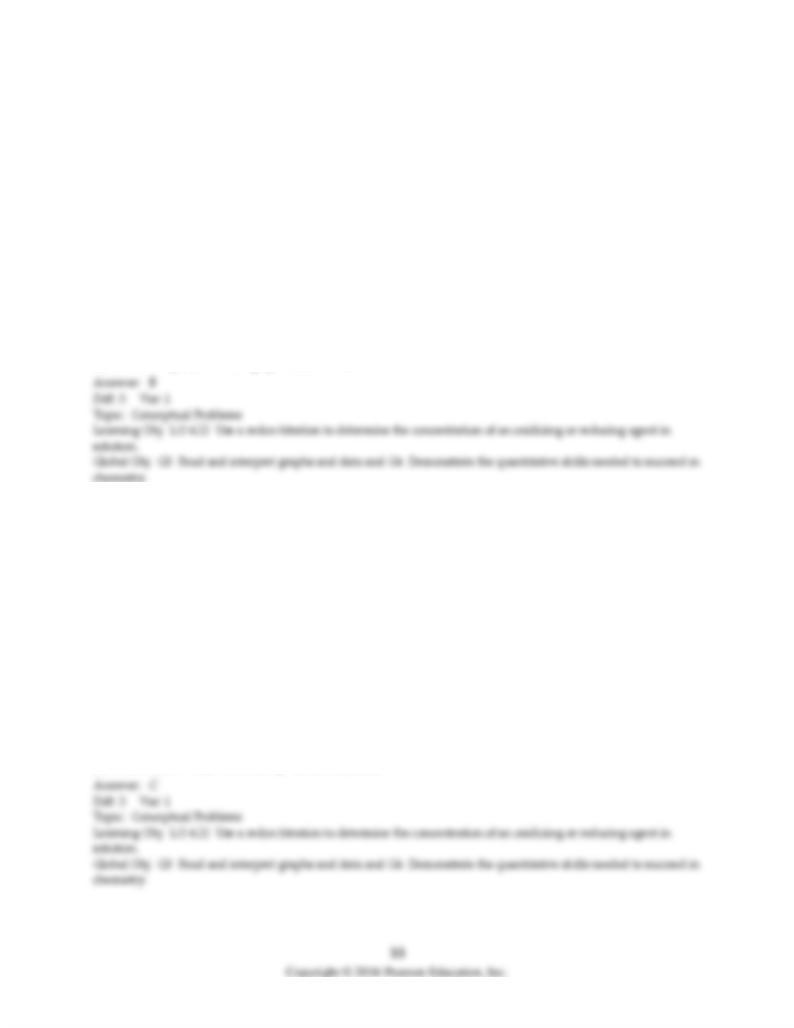
97) The concentration of an aqueous solution of I3⁻ can be determined by a redox titration with aqueous
sodium thiosulfate, Na2S2O3:
2 S2O32- (aq) + I3⁻ (aq) + → S4O62- (aq) + 3 I⁻ (aq)
Assume that the black spheres in the buret represent S2O32- ions, the gray spheres in the flask represent
I3- ions, the concentration of the S2O32- ions in the buret is 0.120 M, and the volumes in the buret and the
flask are identical. What is the concentration of the I3- in the flask, and what fraction of the S2O32-
solution in the buret must be added to the flask to react with all the I3- ions?
A) 0.0400 M I3-; 1/3 of the S2O32- must be added.
B) 0.0400 M I3-; 2/3 of the S2O32- must be added.
C) 0.0600 M I3-; 1/3 of the S2O32- must be added.
D) 0.0600 M I3-; 2/3 of the S2O32- must be added.
98) The concentration of an aqueous solution of Fe2+ can be determined by a redox titration with aqueous
bromate ion, BrO3⁻:
6 Fe2+ (aq) + BrO3⁻ (aq) + 6 H⁺ (aq) → 6 Fe3+ (aq) + Br⁻ (aq) + 3 H2O (l)
Assume that the black spheres in the buret represent BrO3⁻ ions, the gray spheres in the flask represent
Fe2+ ions, the concentration of the BrO3⁻ ions in the buret is 0.120 M, and the volumes in the buret and
the flask are identical. What is the concentration of the Fe2+ in the flask, and what fraction of the BrO3⁻
solution in the buret must be added to the flask to react with all the Fe2+ ions?
A) 0.0200 M Fe2+; 1/18 of the BrO3⁻ must be added.
B) 0.0200 M Fe2+; 1/3 of the BrO3⁻ must be added.
C) 0.0400 M Fe2+; 1/18 of the BrO3⁻ must be added.
D) 0.0400 M Fe2+; 1/3 of the BrO3⁻ must be added.
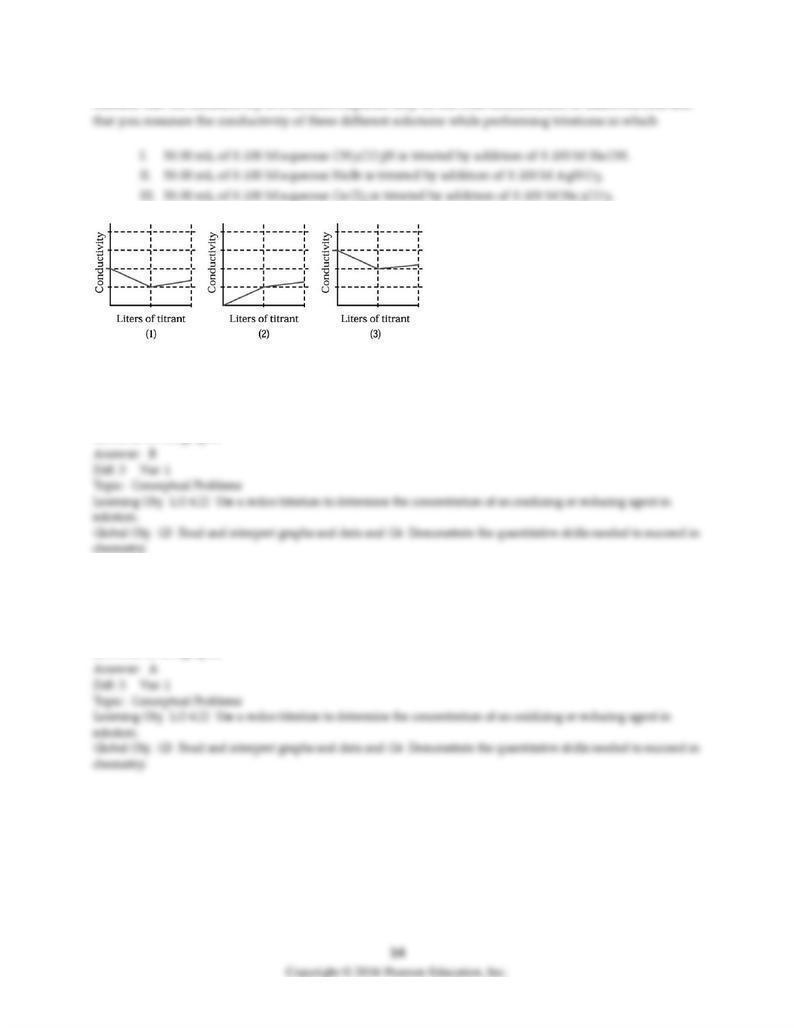
Assume that the conductivity of a solution depends only on the total concentration of dissolved ions and
99) Which of the above graphs corresponds to titration I?
A) graph (1)
B) graph (2)
C) graph (3)
D) None of the graphs
100) Which of the above graphs corresponds to titration II?
A) graph (1)
B) graph (2)
C) graph (3)
D) None of the graphs
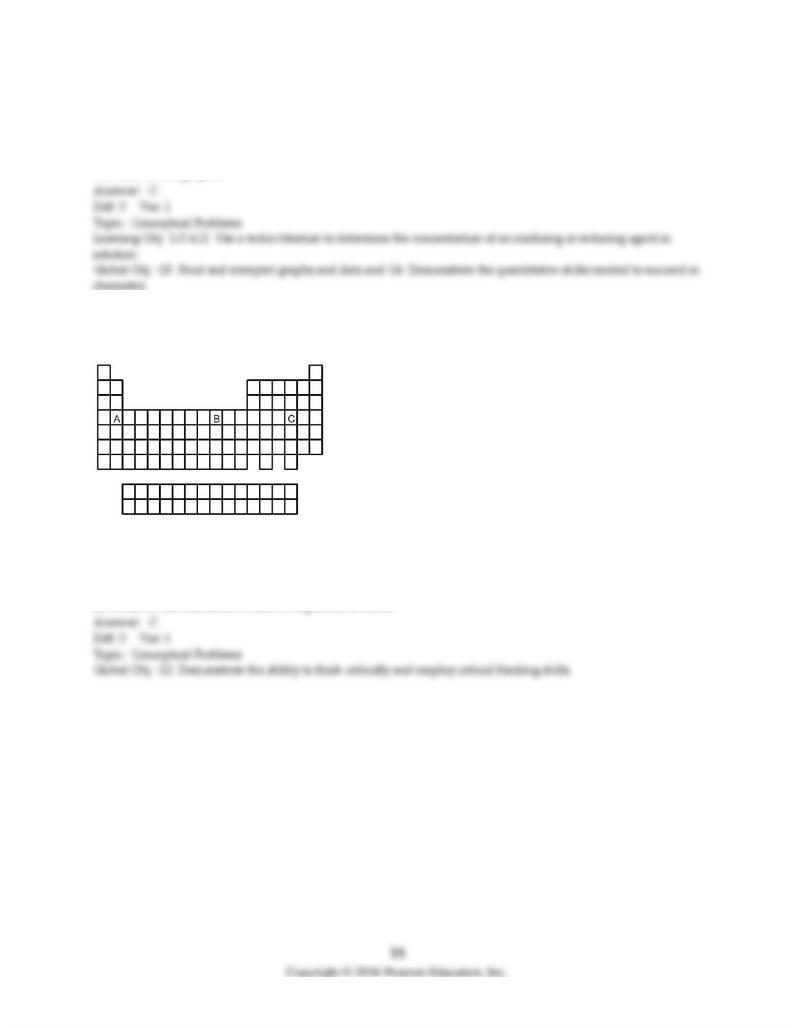
101) Which of the above graphs corresponds to titration III?
A) graph (1)
B) graph (2)
C) graph (3)
D) None of the graphs
102) Based on the positions in the periodic table of elements A, B, and C, which of the following reactions
would you expect to occur?
A) A2+ + B → A + B2+
B) B2+ + C → B + C2+
C) C + A → C2- + A2+
D) None of the reactions would be expected to occur.
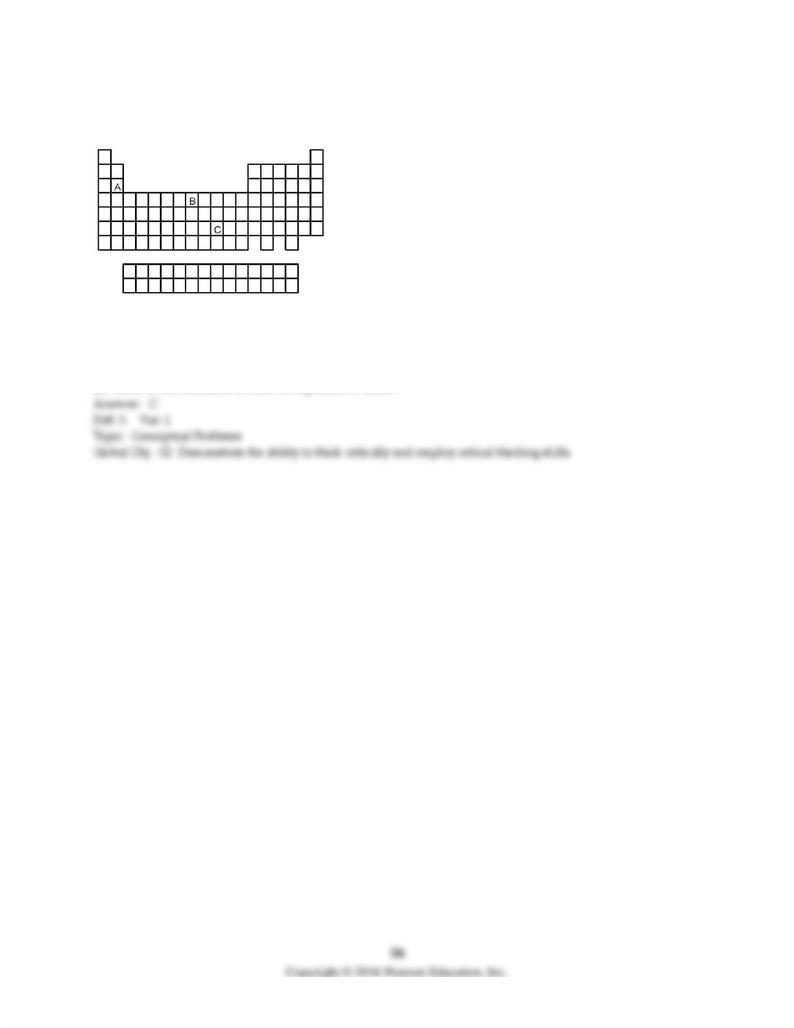
103) Based on the positions in the periodic table of elements A, B, and C, which of the following reactions
would you expect to occur?
A) A2+ + B → A + B2+
B) B2+ + C → B + C2+
C) C2+ + A → C + A2+
D) None of the reactions would be expected to occur.
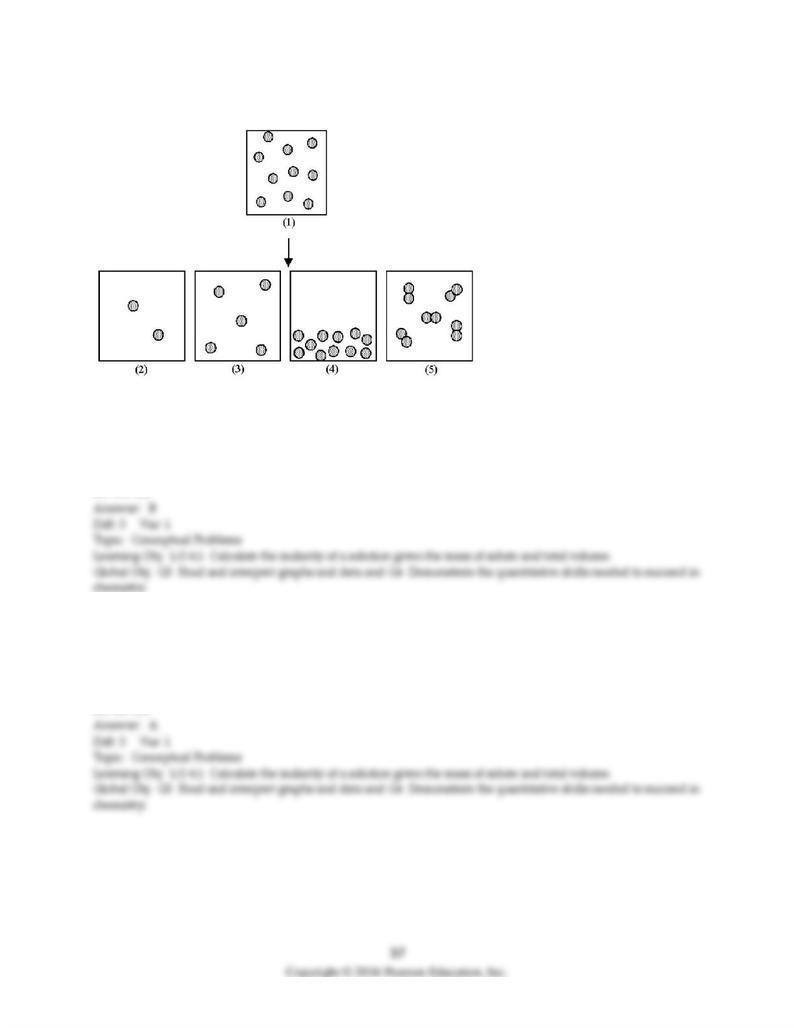
Box (1) represents 1.0 mL of a solution of particles at a given concentration.
104) Which of the boxes (2)-(5) represents 1.0 mL of the solution that results after (1) has been diluted by
adding enough solvent to make 2.0 mL of solution?
A) box (2)
B) box (3)
C) box (4)
D) box (5)
105) Which of the boxes (2)-(5) represents 1.0 mL of the solution that results after (1) has been diluted by
adding enough solvent to make 5.0 mL of solution?
A) box (2)
B) box (3)
C) box (4)
D) box (5)

Assume that the unshaded spheres in the buret represent H+ ions, the shaded spheres in the flask
106) If the volumes in the buret and the flask are identical and the concentration of the acid in the buret is
0.250 M, what is the concentration of the base in the flask?
A) 0.167 M
B) 0.250 M
C) 0.375 M
D) 0.667 M
107) If the volumes in the buret and the flask are identical and the concentration of the acid in the buret is
0.500 M, what is the concentration of the base in the flask?
A) 0.333 M
B) 0.500 M
C) 0.667 M
D) 0.750 M
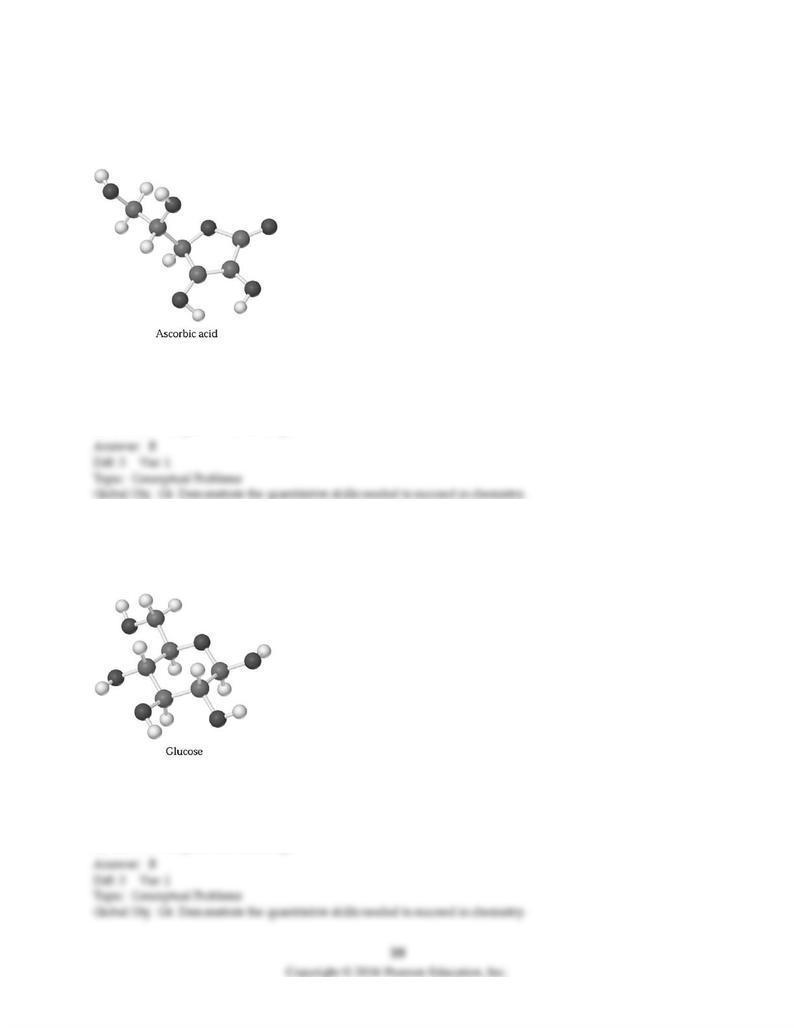
108) Ascorbic acid, C6H806, can be represented by the molecular model shown below. If 1.00 mol of
ascorbic acid is submitted to combustion analysis, how many moles of CO2 and how many moles of H2O
would be formed?
A) 3.00 mol CO2 and 2.00 mol H2O
B) 6.00 mol CO2 and 4.00 mol H2O
C) 6.00 mol CO2 and 8.00 mol H2O
D) 12.0 mol CO2 and 10.0 mol H2O
109) Glucose, C6H1206, can be represented by the molecular model shown below. If 1.00 mol of glucose is
submitted to combustion analysis, how many moles of CO2 and how many moles of H2O would be
formed?
A) 1.00 mol CO2 and 2.00 mol H2O
B) 6.00 mol CO2 and 6.00 mol H2O
C) 6.00 mol CO2 and 12.0 mol H2O
D) 12.0 mol CO2 and 12.0 mol H2O
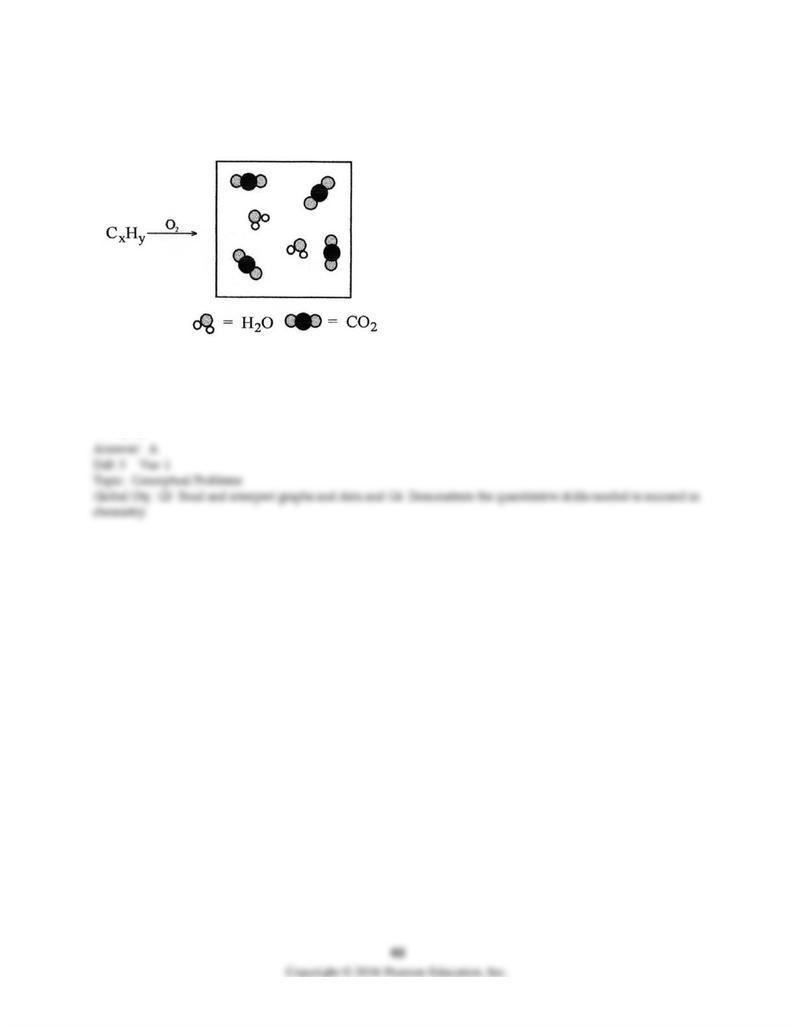
110) A hydrocarbon of unknown formula CxHy was submitted to combustion analysis with the following
results. What is the empirical formula of the hydrocarbon?
A) CH
B) C2H
C) C2H4
D) C4H4

111) A hydrocarbon of unknown formula CxHy was submitted to combustion analysis with the following
results. What is the empirical formula of the hydrocarbon?
A) C5H2
B) C5H4
C) C10H4
D) C10H8
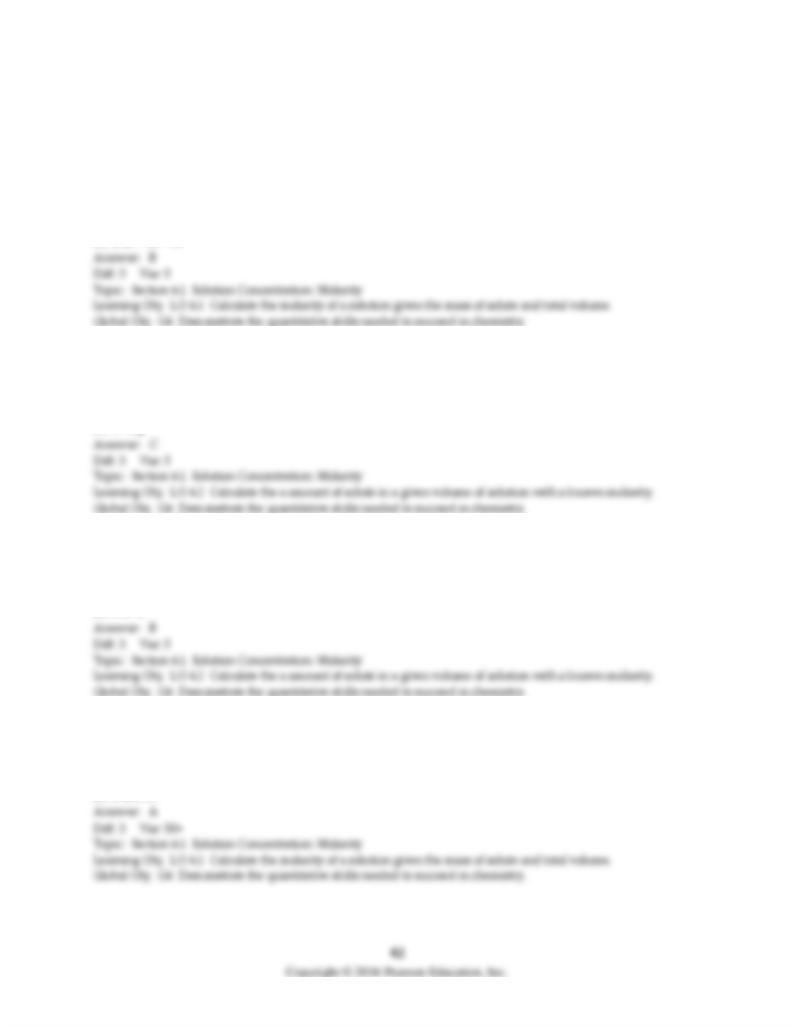
4.2 Algorithmic Questions
1) What is the concentration of FeCl3 in a solution prepared by dissolving 10.0 g of FeCl3 in enough water
to make 275 mL of solution?
A) 2.24 × 10-4 M
B) 0.224 M
C) 4.46 M
D) 4.46 × 103 M
2) How many grams of AgNO3 are needed to make 250. mL of a solution that is 0.140 M?
A) 0.0951 g
B) 0.168 g
C) 5.95 g
D) 95.1 g
3) What volume of a 0.540 M NaOH solution contains 13.5 g of NaOH?
A) 0.182 L
B) 0.625 L
C) 1.60 L
D) 5.49 L
4) What is the concentration of 200. mL of 0.500 M LiF?
A) 0.500 M
B) 1.00 M
C) 0.250 M
D) 0.400 M

5) What is the concentration of HCl in the final solution when 65 mL of a 6.0 M HCl solution is diluted
with pure water to a total volume of 0.15 L?
A) 1.4 × 10-2 M
B) 2.6 M
C) 14 M
D) 2.6 × 103 M
6) How many milliliters of a 9.0 M H2SO4 solution are needed to make 0.45 L of a 3.5 M solution?
A) 0.18 mL
B) 1.2 mL
C) 180 mL
D) 1200 mL
7) A student prepared a stock solution by dissolving 15.0 g of KOH in enough water to make 150. mL of
solution. She then took 15.0 mL of the stock solution and diluted it with enough water to make water to
make 65.0 mL of a final solution. What is the concentration of KOH for the final solution?
A) 0.411 M
B) 0.534 M
C) 1.87 M
D) 2.43 M
8) A student left 40.0 mL of a bottle of 12.0 M HCl out overnight. The next morning, the bottle has only
35.7 mL of liquid left. Assuming that the volume change is only due to loss of water, what will be the
molarity if the remaining solution is diluted to 150 mL?
A) 6.0 M
B) 2.86 M
C) 3.20 M
D) 12.0 M

9) Which contains the greatest number of bromide ions?
A) 50 mL of 2.0 M KBr
B) 100 mL of 1.0 M BaBr2
C) 20 mL of 2.5 M FeBr3
D) All contain the same number of chloride ions.
10) What is the concentration of NO3- ions in a solution prepared by dissolving 20.0 g of Ca(NO3)2 in
enough water to produce 300. mL of solution?
A) 0.203 M
B) 0.406 M
C) 0.537 M
D) 0.813 M
11) If the reaction of phosphate ion with water is ignored, what is the total concentration of ions in a
solution prepared by dissolving 7.00 g of K3PO4 in enough water to make 350. mL of solution?
A) 0.0236 M
B) 0.0943 M
C) 0.377 M
D) 0.754 M
12) What is the concentration of an AlCl3 solution if 150. mL of the solution contains 250. mg of Cl- ion?
A) 1.57 × 10-2 M
B) 3.75 × 10-2 M
C) 4.70 × 10-2 M
D) 1.41 × 10-1 M
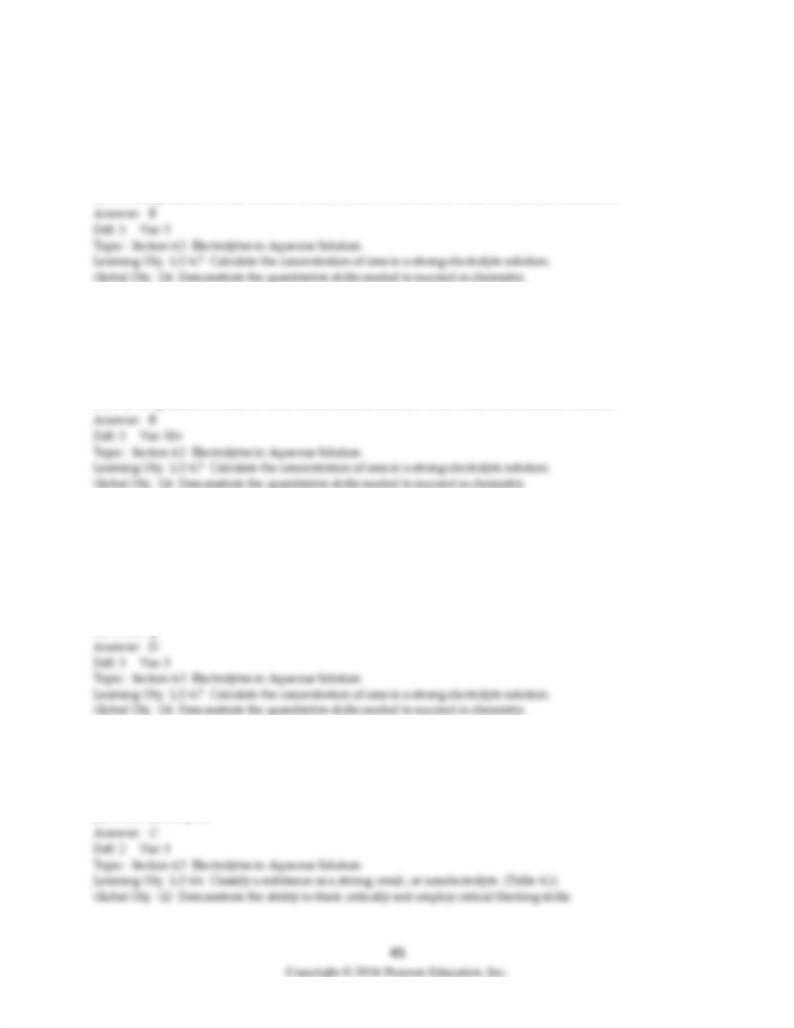
13) How many mL of a 0.175 M FeCl3 solution are needed to make 550. mL of a solution that is 0.300 M in
Cl- ion?
A) 0.943 mL
B) 314 mL
C) 943 mL
D) It is not possible to make a more concentrated solution from a less concentrated solution.
14) How many mL of a 0.350 M AlI3 solution are needed to make 700. mL of a solution that is 0.350 M in
I- ion?
A) 500 mL
B) 167 mL
C) 125 mL
D) It is not possible to make a more concentrated solution from a less concentrated solution.
15) A student dissolved 3.00 g of Co(NO3)2 in enough water to make 100. mL of stock solution. He took
4.00 mL of the stock solution and then diluted it with water to give 275. mL of a final solution. How many
grams of NO3- ion are there in the final solution?
A) 0.0148 g
B) 0.0296 g
C) 0.0407 g
D) 0.0813 g
16) H Br , HCl , H ClO4, K Br , and NaCl are all classified as
A) acids.
B) nonelectrolytes.
C) strong electrolytes.
D) weak electrolytes.
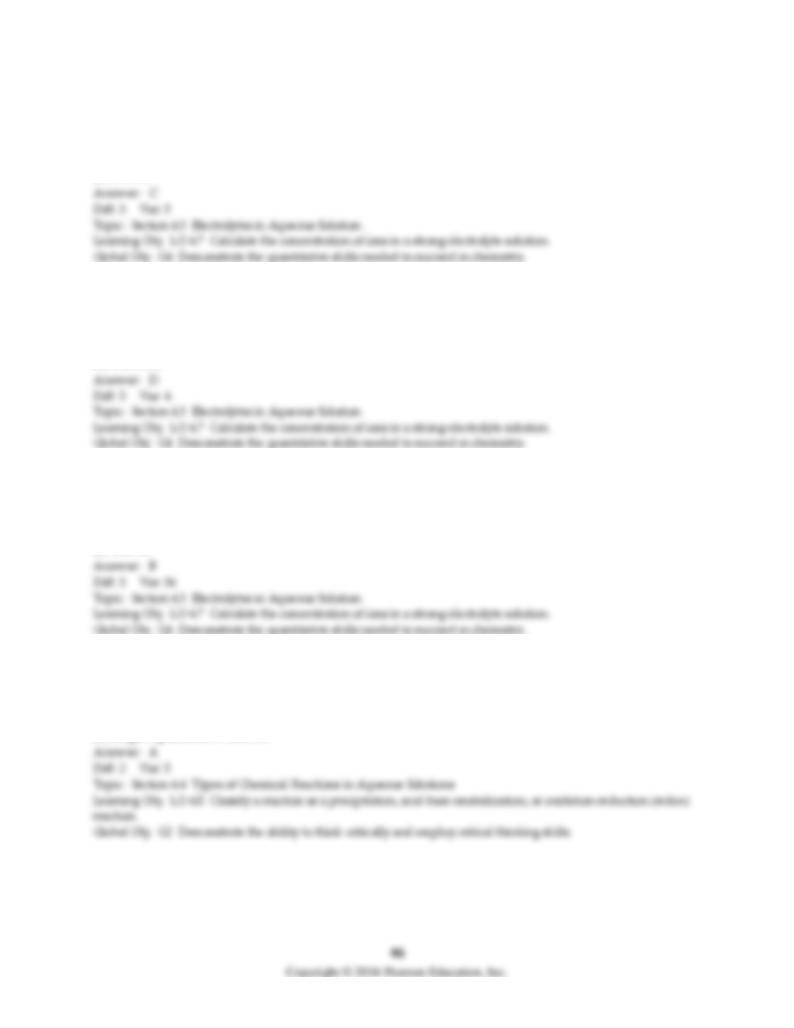
17) What is the molar concentration of sodium ions in a 0.750 M Na3PO4 solution?
A) 0.250 M
B) 0.750 M
C) 2.25 M
D) 3.00 M
18) What is the molarity of chloride ions when 10.4 grams of MgCl2 is dissolved in 753 mL of water?
A) 0.00 M
B) 0.145 M
C) 0.000290 M
D) 0.290 M3
19) What is the molar concentration of sulfate ions in a 0.450 M K2SO4 solution?
A) 0.225 M
B) 0.450 M
C) 0.900 M
D) 1.35 M
20) The reaction HNO3(aq) + KOH(aq) → KNO3(aq) + H2O(l) is best classified as a(n)
A) acid-base neutralization reaction.
B) oxidation-reduction reaction.
C) precipitation reaction.
D) single replacement reaction.
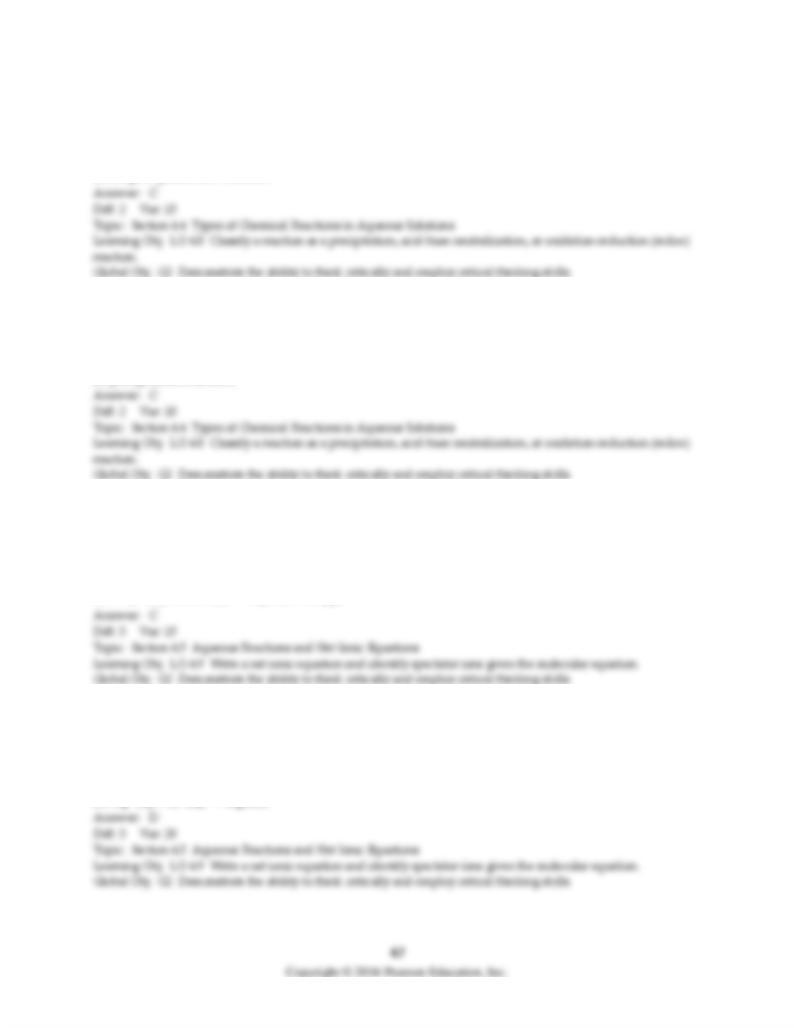
21) The reaction Sr(NO3)2(aq) + Cs2SO4(aq) → SrSO4(s) + 2 CsNO3(aq) is best classified as a(n)
A) acid-base neutralization reaction.
B) oxidation-reduction reaction.
C) precipitation reaction.
D) single replacement reaction.
22) The reaction Ba(s) + 2 AgNO3(aq) → Ba(NO3)2(aq) + 2 Ag(s) is best classified as a(n)
A) acid-base neutralization reaction.
B) double replacement reaction.
C) oxidation-reduction reaction.
D) precipitation reaction.
23) Write a balanced net ionic equation for the reaction of Li2CO3(s) and HCl(aq).
A) Li2CO3(s) + 2 HCl(aq) → 2 LiCl(aq) + H2O(l) + CO2(g)
B) 2Li+(aq) + CO32-(aq) + 2H+(aq) + 2Cl-(aq) → 2Li+(aq) + 2Cl-(aq) + H2O(l) + CO2(g)
C) Li2CO3(s) + 2 H+(aq) → 2 Li+(aq) + H2O(l) + CO2(g)
D) CO32-(aq) + 2 H+(aq) → H2O(l) + CO2(g)
24) Write a balanced net ionic equation for the reaction of AgNO3(aq) with LiCl(aq).
A) AgNO3(aq) + LiCl(aq) → AgCl(aq) + LiNO3(s)
B) Ag+(aq) + NO3-(aq) + Li+(aq) + Cl-(aq) → Ag+(aq) + Cl-(aq) + LiNO3(s)
C) Ag+(aq) + NO3-(aq) + Li+(aq) + Cl-(aq) → AgBr(s) + Li+(aq) + NO3-(aq)
D) Ag+(aq) + Br-(aq) → AgBr(s)
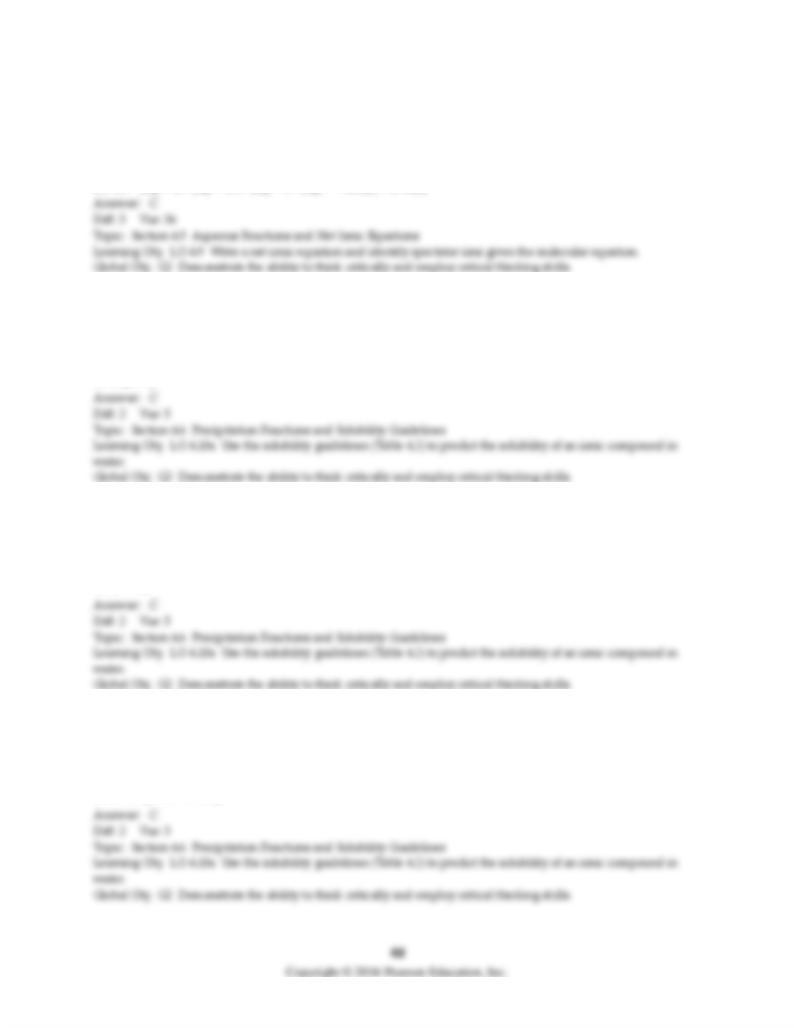
25) Write a balanced net ionic equation for the reaction of CaI2(aq) with K2S(aq).
A) CaI2(aq) + K2S(aq) → CaS (aq) + 2 KI(aq)
B) Ca2+(aq) + 2 I-(aq) + 2 K+(aq) + S2-(aq) → CaS(s) + 2 KI(aq)
C) Ca2+(aq) + S2-(aq) → CaS(s)
D) Ca2+(aq) + 2 I-(aq) + 2 K+(aq) + S2-(aq) → CaS(s) + 2 KI(s)
26) Which one of the following compounds is insoluble in water?
A) Na2SO4
B) KNO3
C) Ba SO4
D) Li2CO3
27) Which one of the following compounds is soluble in water?
A) Cu3(PO4)2
B) FeS
C) Hg(NO3)2
D) SrCO3
28) Which pair of compounds is soluble in water?
A) Hg2Br2 and Hg2I2
B) CuS and Na2S
C) LiI and Ca(NO3)2
D) K NO3 and CaCO3
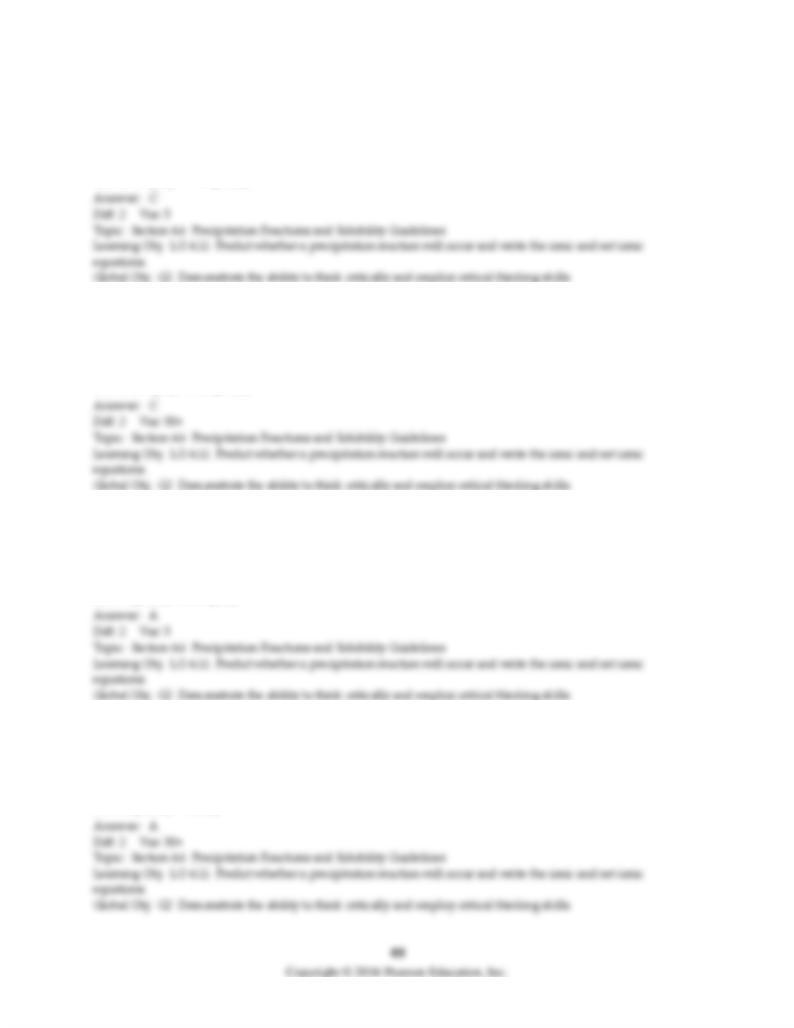
29) The mixing of which pair of reactants will result in a precipitation reaction?
A) CsI(aq) + NaOH(aq)
B) HCl(aq) + Ca(OH)2(aq)
C) K2SO4(aq) + Pb (NO3)2(aq)
D) NaNO3(aq) + NH4Cl(aq)
30) The mixing of which pair of reactants will result in a precipitation reaction?
A) CsCl(aq) + KOH(aq)
B) HCl(aq) + Ca(OH)2(aq)
C) Li2CO3(aq) + Ca(NO3)2(aq)
D) NaClO4(aq) + NH4Cl(aq)
31) The mixing of which pair of reactants will result in a precipitation reaction?
A) Ni(NO3)2(aq) + Na2CO3(aq)
B) K2SO4(aq) + Cu(NO3)2(aq)
C) NaClO4(aq) + (NH4)2S(aq)
D) NH4Br(aq) + NH4I(aq)
32) The mixing of which pair of reactants will result in a precipitation reaction?
A) Cu(NO3)2(aq) + Na3PO4(aq)
B) Na2SO4(aq) + KNO3(aq)
C) LiClO4(aq) + (NH4)2S(aq)
D) NH4Br(aq) + LiI(aq)
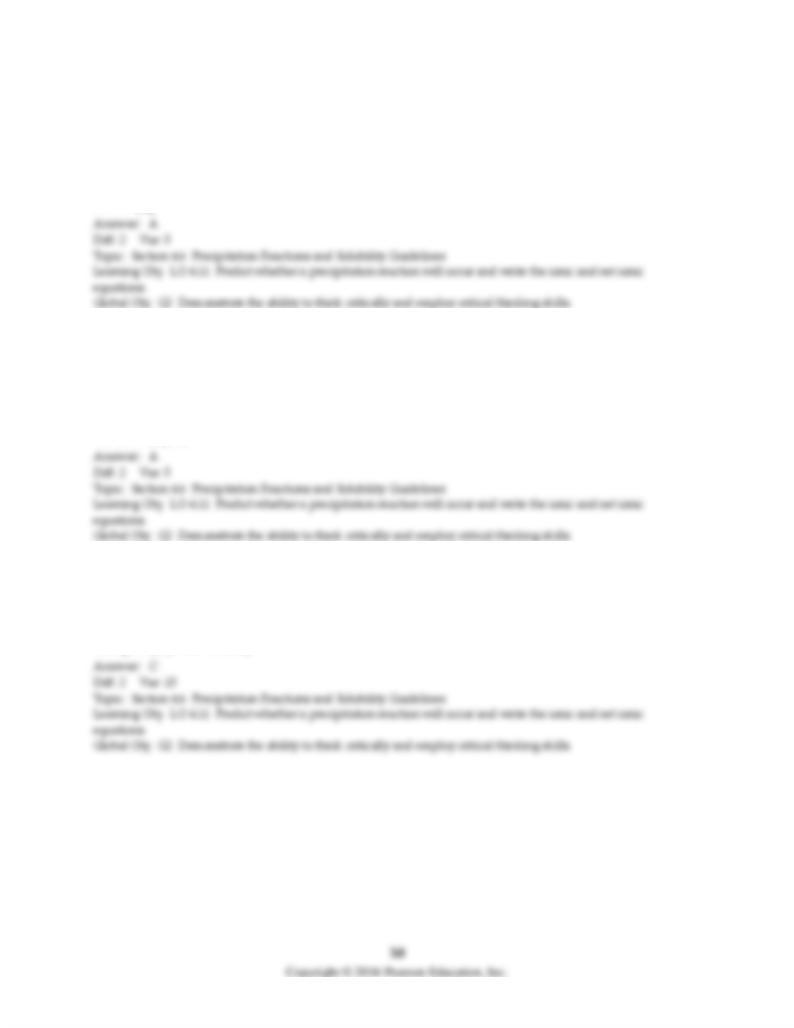
33) What reagent could be used to separate I- from CH3CO2- when added to an aqueous solution
containing both?
A) AgNO3 (aq)
B) Ba(OH)2 (aq)
C) CuSO4 (aq)
D) NaI (aq)
34) What reagent could not be used to separate Br- from CO32- when added to an aqueous solution
containing both?
A) AgNO3 (aq)
B) Ca(NO3)2 (aq)
C) Cu(NO3)2 (aq)
D) Fe(NO3)2(aq)
35) Predict the products of a reaction between AgNO3(aq) and CsBr(aq).
A) Ag(s) and NO(g)
B) Ag(s) and Br2(l)
C) AgBr(s) and CsNO3(aq)
D) AgNO3(aq) and CsBr(aq)
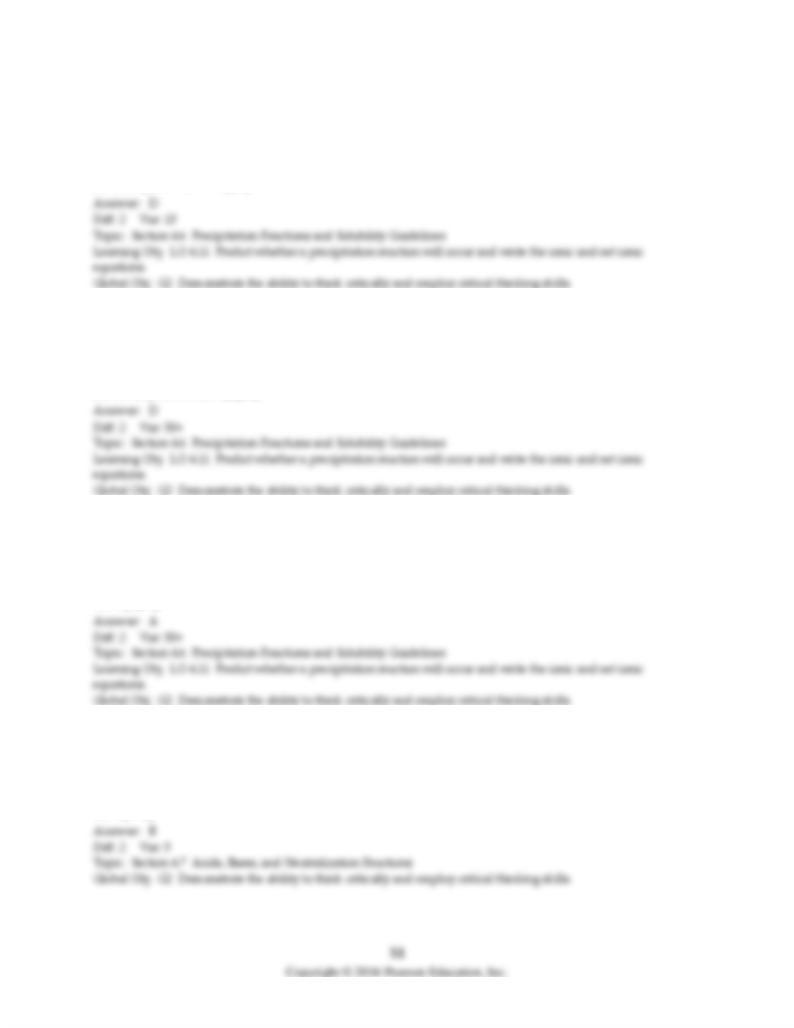
36) Predict the products of a reaction between Sr(NO3)2(aq) and Rb2SO4(aq).
A) Sr(s), RbNO3(aq) and Rb2SO3(aq)
B) SrSO3(s) and RbNO2(aq)
C) SrSO3(s) and RbNO3(aq)
D) SrSO4(s) and RbNO3(aq)
37) Which pair of reactants will produce a precipitate when mixed together?
A) HI(aq) and KOH(aq)
B) HCl(aq) and Li2CO3(aq)
C) HCl(aq) and K2S(aq)
D) HBr(aq) and Pb(NO3)2(aq)
38) What reagent would distinguish between Ba2+ and Pb2+?
A) KCl
B) LiNO3
C) K2SO4
D) Li2S2O3
39) Which of the following compounds is not an Arrhenius acid?
A) CH3CO2H
B) C3H7NH2
C) HNO2
D) H2SO4
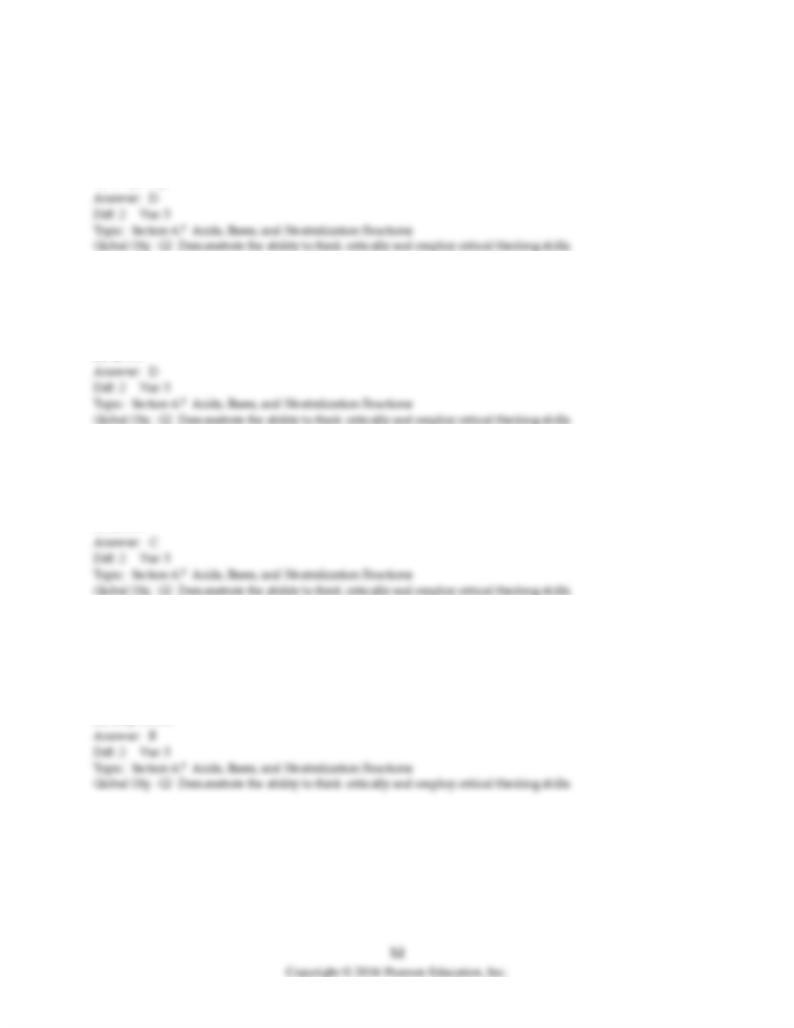
40) Which of the following compounds is an Arrhenius base?
A) C6H12O6
B) HOCl
C) H2SO4
D) CH3NH2
41) Which of the following compounds is an Arrhenius base?
A) CH3OH
B) CH3CO2H
C) HOCl
D) LiOH
42) Which one of the following compounds behaves as an acid when dissolved in water?
A) SrO
B) C3H8
C) HCl
D) LiOH
43) Which of the compounds of H NO2, Ra(OH)2, FrOH, and HI, behave as acids when they are
dissolved in water?
A) Ra(OH)2 and FrOH
B) H NO2 and HI
C) only HI
D) only FrOH
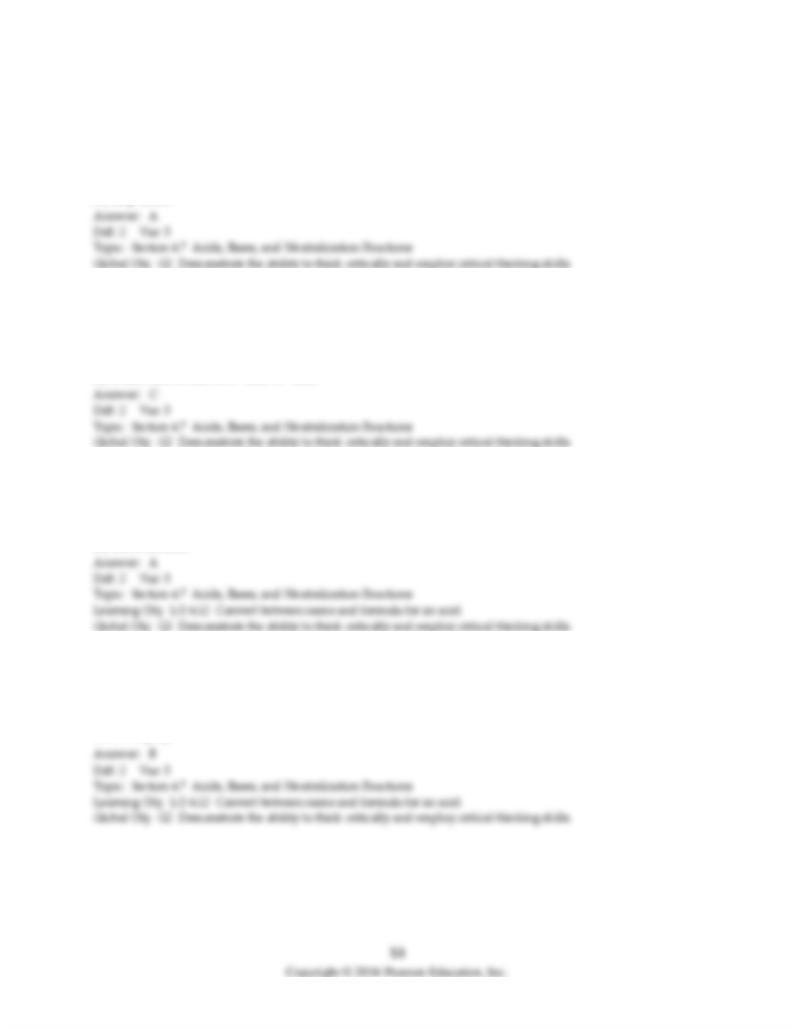
44) Which of the compounds H3PO4, Mg(OH)2, LiOH, and HCl, behave as bases when they are dissolved
in water?
A) Mg(OH)2 and LiOH
B) H3PO4 and HCl
C) only HCl
D) only LiOH
45) When dissolved in water, NaOH behaves as
A) an acid that forms Na+ and OH- ions.
B) an acid that forms NaO- and H+ ions.
C) a base that forms Na+ and OH- ions.
D) a base that forms NaO- and H+ ions.
46) An aqueous solution of H Cl is named
A) hydrochloric acid.
B) hydrochlorous acid.
C) chloric acid.
D) chlorous acid.
47) The chemical formula for iodous acid is
A) H IO(aq).
B) HIO2(aq).
C) HIO3(aq).
D) H I O4(aq).
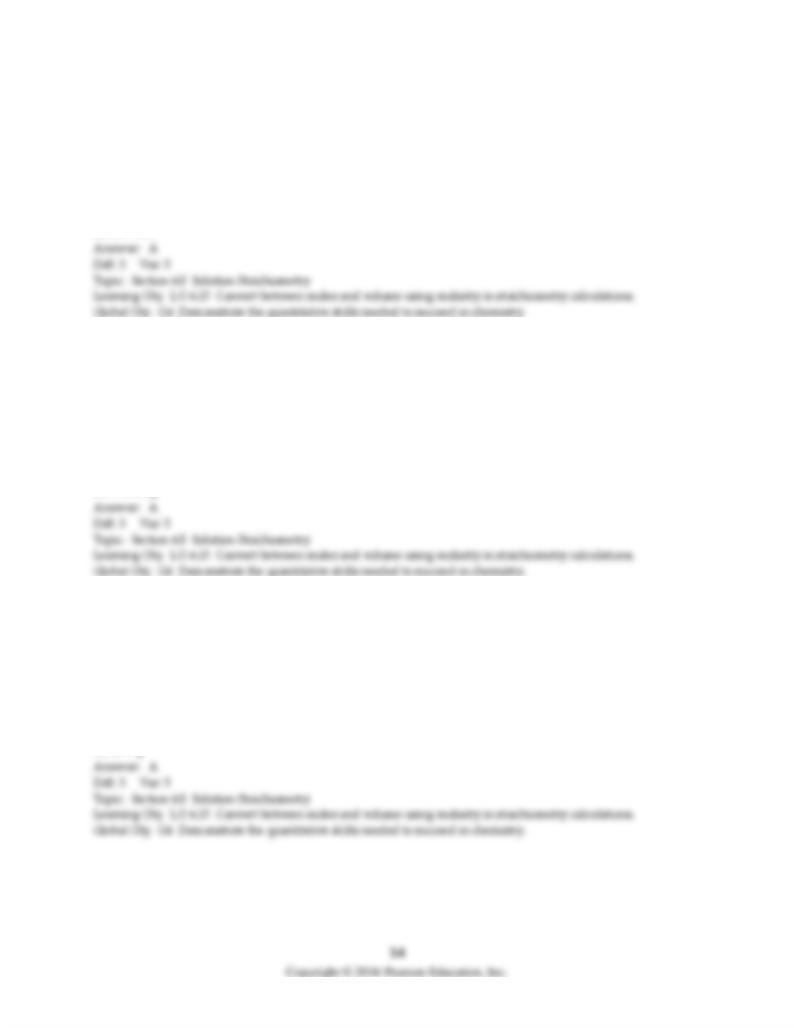
48) How many milliliters of 0.260 M Na2S are needed to react with 45.00 mL of 0.315 M AgNO3?
Na2S(aq) + 2 AgNO3(aq) → 2 NaNO3(aq) + Ag2S(s)
A) 27.3 mL
B) 54.5 mL
C) 74.3 mL
D) 109 mL
49) How many grams of CaCl2 are formed when 25.00 mL of 0.00237 M Ca(OH)2 reacts with excess Cl2
gas?
2 Ca(OH)2(aq) + 2 Cl2(g) → Ca(OCl)2(aq) + CaCl2(s) + 2 H2O(l)
A) 0.00329 g
B) 0.00658 g
C) 0.0132 g
D) 0.0304 g
50) When 125 mL of 0.500 M AgNO3 is added to 100. mL of 0.300 M NH4Cl, how many grams of AgCl
are formed?
AgNO3(aq) + NH4Cl(aq) → AgCl(s) + NH4NO3(aq)
A) 4.30 g
B) 8.96 g
C) 13.3 g
D) 25.8 g
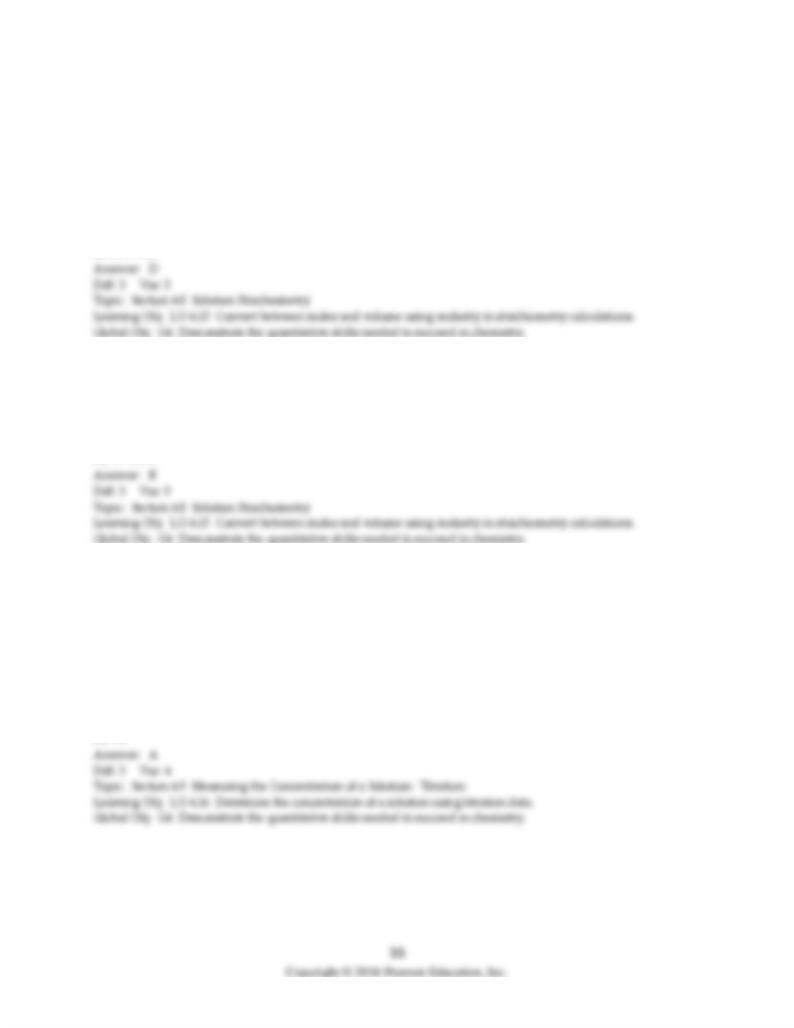
51) How many milliliters of 0.200 M FeCl3 are needed to react with an excess of Na2S to produce 0.345 g
of Fe2S3 if the percent yield for the reaction is 65.0%?
3 Na2S(aq) + 2 FeCl3(aq) → Fe2S3(s) + 6 NaCl(aq)
A) 6.38 mL
B) 10.8 mL
C) 12.8 mL
D) 25.5 mL
52) If 100. mL of 0.200 M Na2SO4 is added to 200. mL of 0.300 M NaCl, what is the concentration of Na+
ions in the final solution? Assume that the volumes are additive.
A) 0.267 M
B) 0.333 M
C) 0.500 M
D) 0.700 M
53) The unknown acid H2X can be neutralized completely by NaOH according to the following equation:
H2X(aq) + NaOH(aq) → Na2X + H2O
To completely neutralize this reaction, 250 mL of 0.13 M NaOH were needed. How many moles of H2X
were present?
A) 0.033
B) 0.065
C) 0.016
D) 3.8
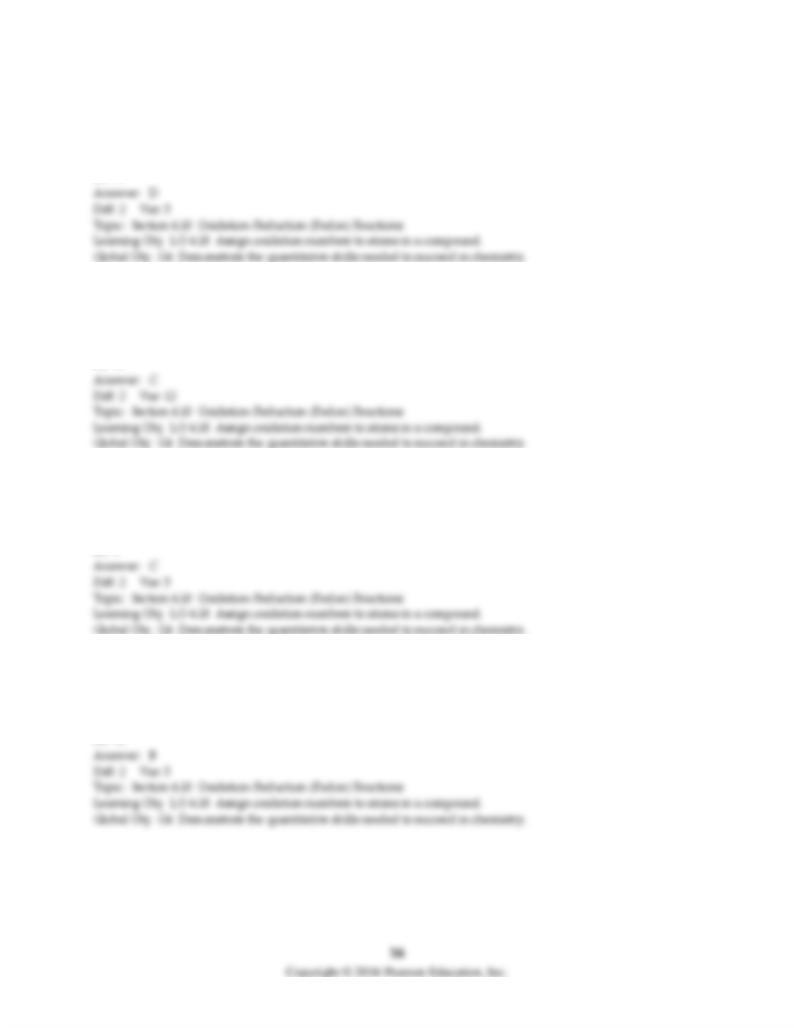
54) What is the oxidation number of the sulfur atom in Li2SO4?
A) -2
B) +2
C) +4
D) +6
55) What is the oxidation number of the sulfur atom in Cs2SO3?
A) -2
B) +2
C) +4
D) +6
56) What is the oxidation number of the chromium atom in Li2Cr2O4?
A) -2
B) +2
C) +6
D) +7
57) What is the oxidation number of the oxygen atom in O22-?
A) -2
B) -1
C) +1
D) +2
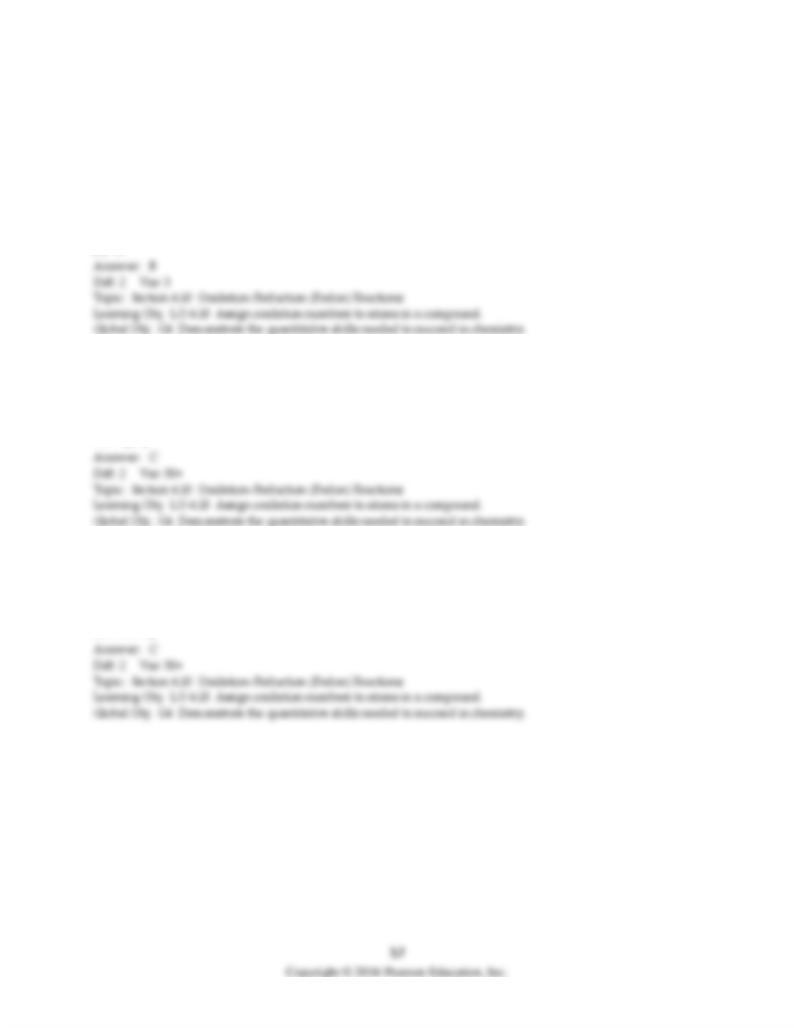
58) What is the oxidation number change for the chromium atom in the following unbalanced reduction
half reaction?
Cr2O72-(aq) + H+(aq) → Cr3+(aq) + H2O(l)
A) -7
B) -3
C) +3
D) +6
59) In which compound is the oxidation state of oxygen not -2?
A) MgO
B) Na2O
C) K2O2
D) Al2O3
60) In which compound is the oxidation state of hydrogen not +1?
A) H2S
B) H2O2
C) KH
D) KHSO4
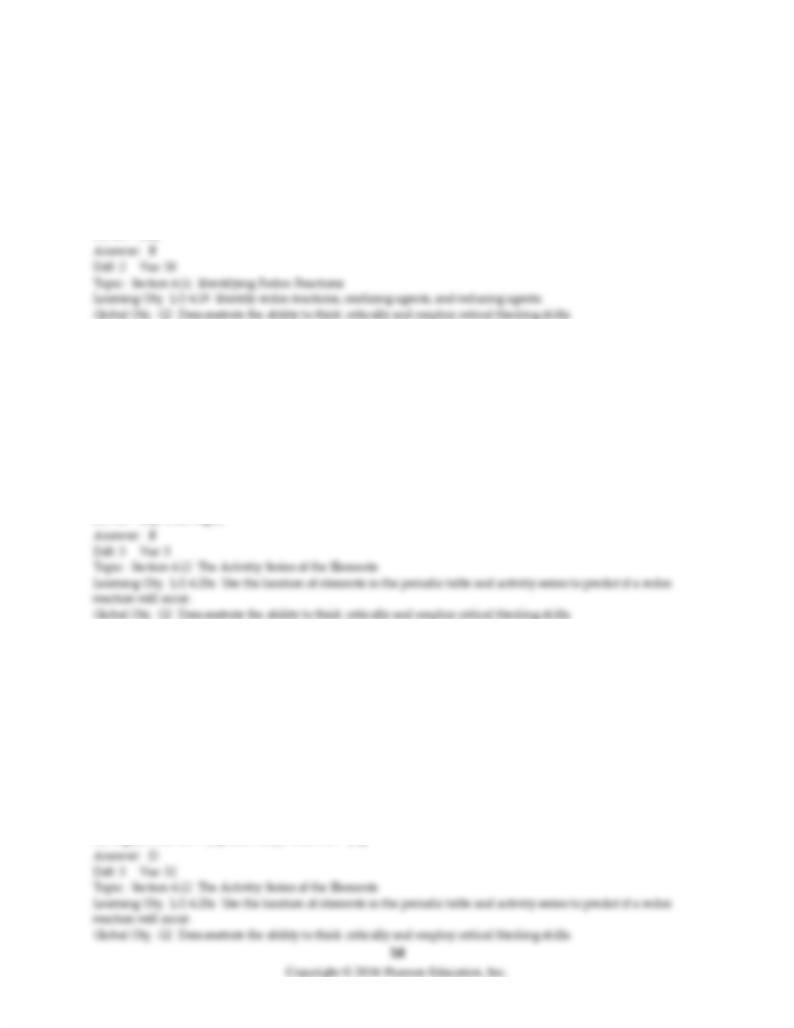
61) Which species functions as the oxidizing agent in the following reduction-oxidation reaction?
Zn(s) + Ni2+(aq) → Ni(s) + Zn2+(aq)
A) Ni(s)
B) Ni2+(aq)
C) Zn(s)
D) Zn2+(aq)
62) Using the following portion of the activity series for oxidation half reactions, determine which
combination of reactants will result in a reaction.
Ca(s) → Ca2+(aq) + 2 e-
Ag(s) → Ag +(aq) + e-
A) Ca(s) with Ag(s)
B) Ca(s) with Ag +(aq)
C) Ca2+(aq) with Ag +(aq)
D) Ca2+(aq) with Ag(s)
63) Using the following portion of the activity series for oxidation half reactions
Mg(s) → Mg2+(aq) + 2e-
Co(s) → Co2+(aq) + 2e-
Cu(s) → Cu2+(aq) + 2e-
indicate which pairs of reactions will occur.
A) Cu(s) with Co2+(aq) and Co(s) with Mg2+(aq)
B) Mg(s) with Cu2+(aq) and Co2+(aq) with Mg2+(aq)
C) Mg(s) with Cu(s) and Co(s) with Cu(s)
D) Mg(s) with Co2+(aq) and Co(s) with Cu2+(aq)
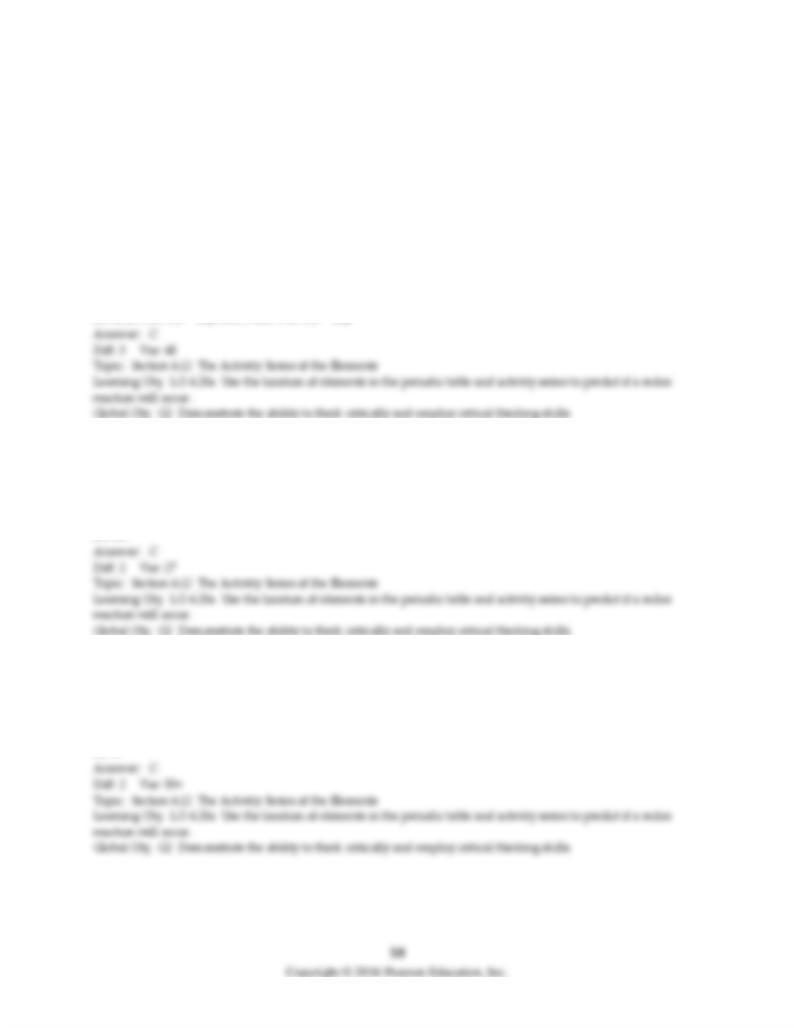
64) Using the following portion of the activity series for oxidation half reactions
Li(s) → Li+(aq) + e-
Al(s) → Al3+(aq) + 3e-
Fe(s) → Fe2+(aq) + 2e-
Pt(s) → Pt2+(aq) + 2e-
determine which pairs of reactions will occur.
A) Al(s) with Fe2+(aq) and Pt(s) with Li+(aq)
B) Fe(s) with Al(s) and Al3+(aq) with Pt2+(aq)
C) Fe(s) with Pt2+(aq) and Al(s) with Pt2+(aq)
D) Li(s) with Al3+(aq) and Fe(s) with Al3+(aq)
65) Coinage metals are metals that are not easily oxidized. Based on the activity series, which metal
would be least desirable as a coinage metal?
A) Mn
B) Au
C) Ca
D) Co
66) Based on the activity series, which metal dissolves in hydrochloric acid to produce hydrogen gas, but
does not react with steam or liquid water?
A) Mg
B) Hg
C) Sn
D) K

67) Which element will react rapidly with aqueous H+ ions and also with liquid H2O?
A) Pt
B) Co
C) Zn
D) Ca
68) Which elementwill not react with liquid water but will react with aqueous H+ ions and steam?
A) K
B) Fe
C) Sn
D) Hg
69) Which element will not react with liquid water or with aqueous H+ ions?
A) Hg
B) Co
C) Zn
D) Li
70) How many milliliters of 0.550 M hydriodic acid are needed to react with 5.00 mL of 0.217 M CsOH?
HI(aq) + CsOH(aq) → CsI(aq) + H2O(l)
A) 0.0789 mL
B) 0.507 mL
C) 1.97 mL
D) 12.6 mL
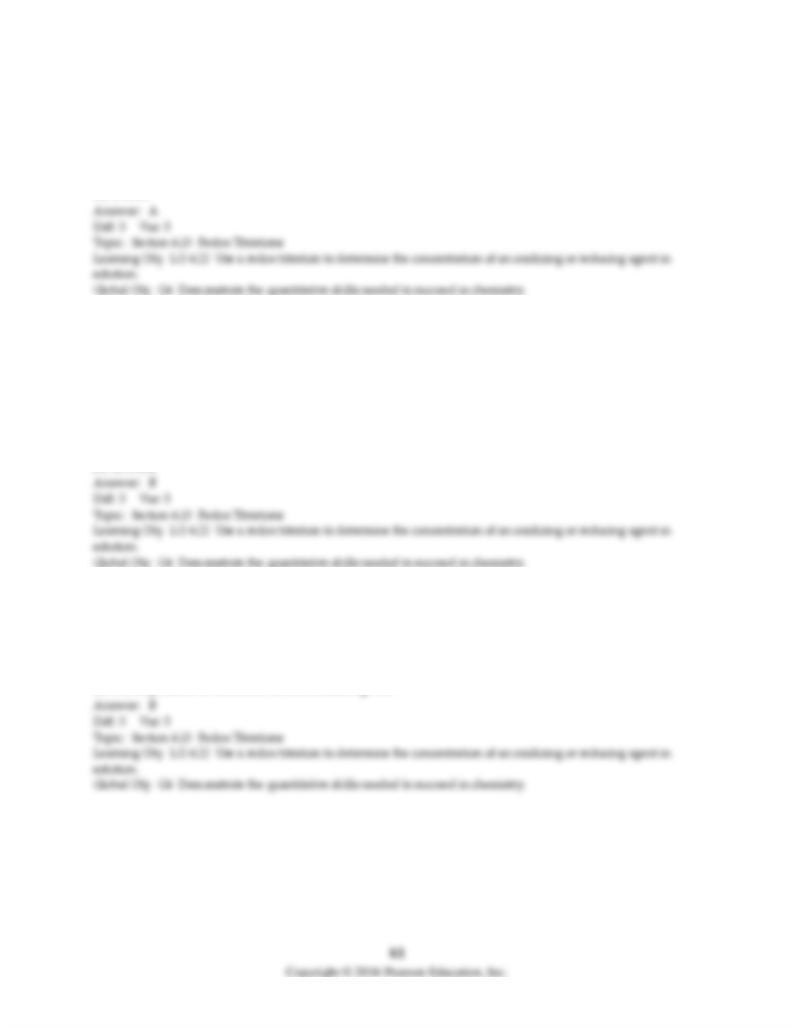
71) In an acid-base neutralization reaction 43.74 mL of 0.500 M potassium hydroxide reacts with 50.00 mL
of sulfuric acid solution. What is the concentration of the H2SO4 solution?
A) 0.219 M
B) 0.437 M
C) 0.875 M
D) 1.14 M
72) Balance the chemical equation given below, and determine the number of milliliters of 0.00300 M
phosphoric acid required to neutralize 25.00 mL of 0.00150 M calcium hydroxide.
________ Ca(OH)2(aq) + ________ H3PO4(aq) → ________ Ca3(PO4)2(aq) + ________ H2O(l)
A) 1.69 mL
B) 8.33 mL
C) 12.5 mL
D) 18.8 mL
73) When 220. mL of 1.50 × 10-4 M hydrochloric acid is added to 125 mL of 1.75 × 10-4 M Mg(OH)2, the
resulting solution will be
A) acidic.
B) basic
C) neutral.
D) It is impossible to tell from the information given.
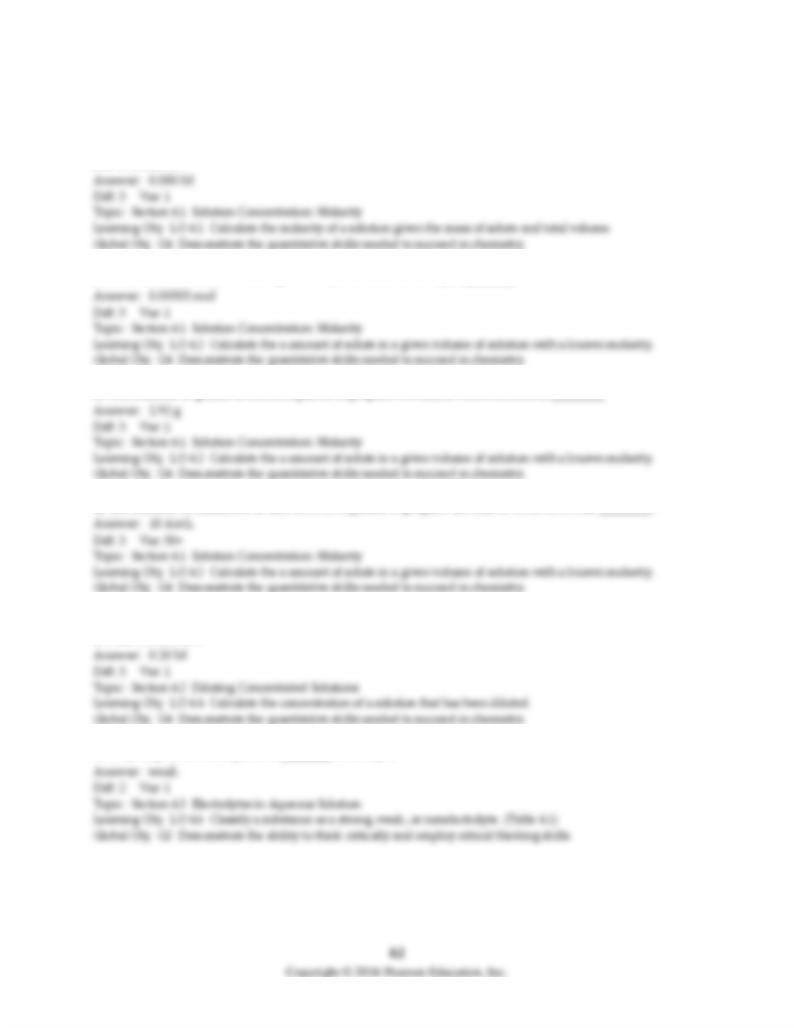
4.3 Short Answer Questions
1) What is the molarity of a solution prepared by dissolving 0.80 g of NaOH in enough water to make 250
mL of solution?
2) The number of moles of CaCl2 in 25.0 mL of 0.222 M CaCl2 is ________.
3) The number of grams of NaCl required to prepare 500 mL of 0.100 M NaCl is ________.
4) The number of milliliters of 12.0 M HCl required to prepare 250 mL of 0.500 M HCl is ________.
5) What is the molarity of a solution prepared by diluting 25 mL of 2.0 M HCl with enough water to make
250 mL of solution?
6) CH3CO2H is an example of a ________ electrolyte.
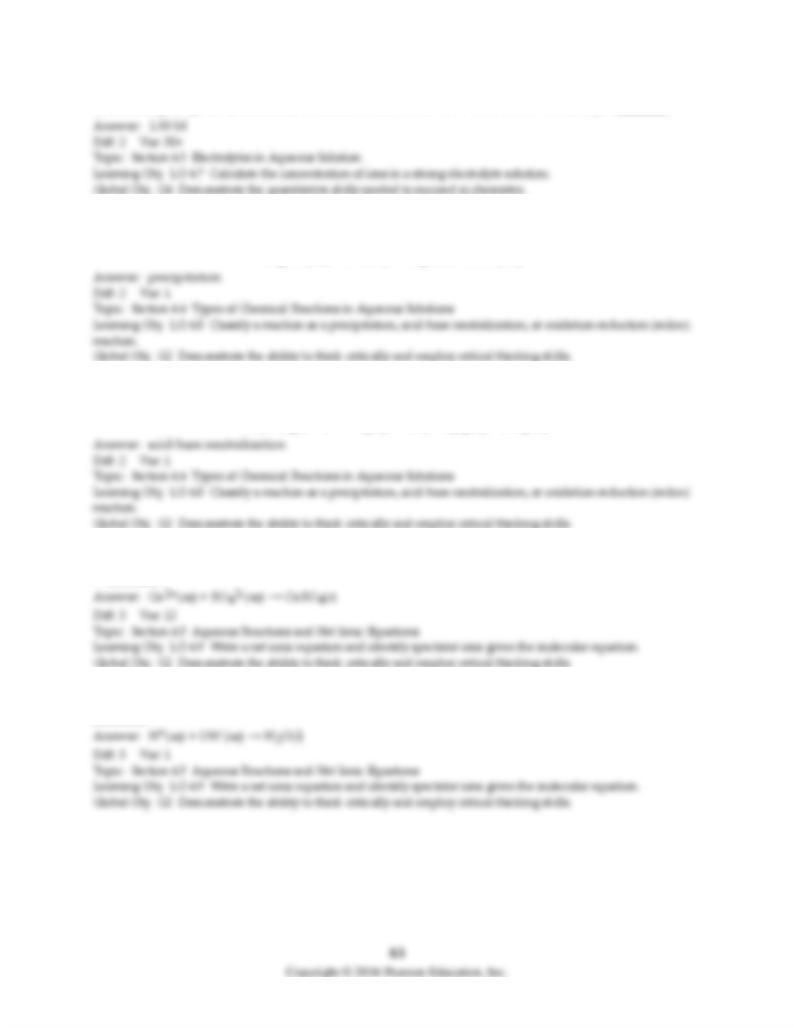
7) Assuming complete dissociation, the molar concentration of Br- ions in 0.500 M BaBr2 is ________.
8) The reaction shown below is classified as a(n) ________ reaction.
AgNO3(aq) + HCl(aq) → AgCl(s) + HNO3(aq)
9) The reaction shown below is classified as a(n) ________ reaction.
Pb(OH)2(s) + 2 HNO3(aq) → Pb(NO3)2(aq) + 2 H2O(l)
10) The balanced net ionic equation for the reaction Li2SO4(aq) + Ca(NO3)2(aq) → CaSO4(s) + 2 LiNO3(aq)
is ________.
11) The balanced net ionic equation for the reaction H2SO4(aq) + 2 KOH(aq) → K2SO4(aq) + 2 H2O(l) is
________.
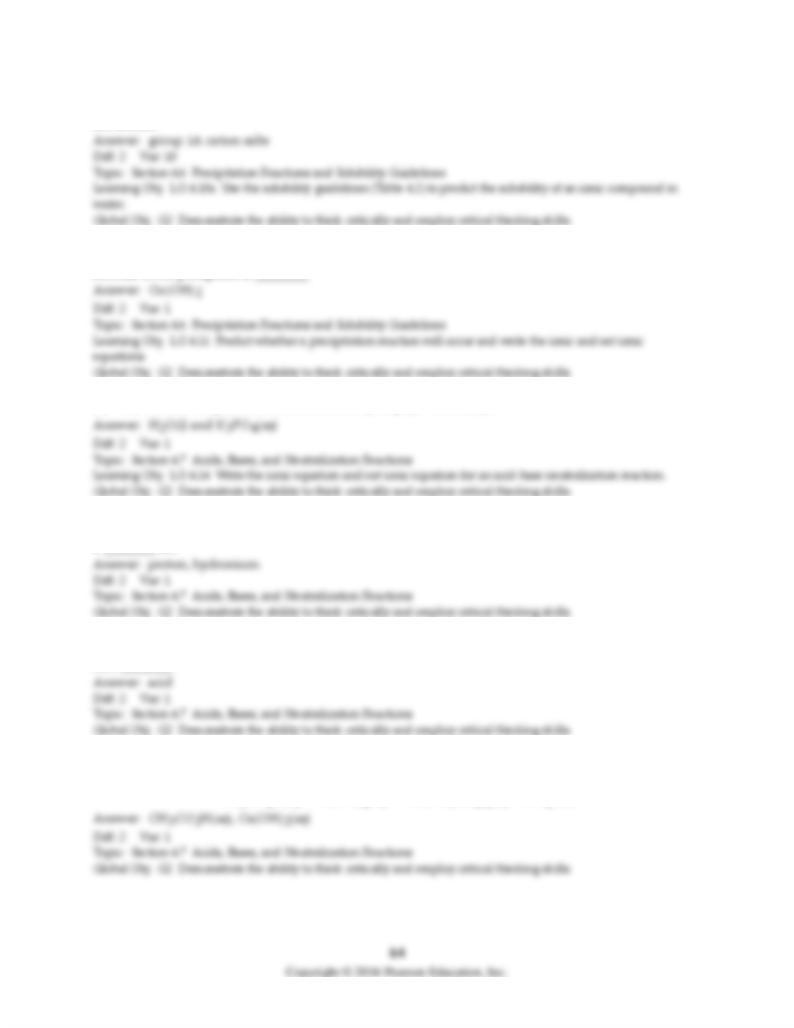
12) The compound K2CO3 is predicted to be soluble based on the solubility guideline that all ________
are soluble.
13) When NaOH(aq) is mixed with CuSO4(aq) a precipitate forms. Based on solubility guidelines the
formula of the precipitate is ________.
14) What are the two products of the reaction H3PO4(aq) + 3 KOH(aq) → ?
15) The hydrogen ion, H+, is also referred to as a ________, and a hydrated hydrogen ion, H3O+, is called
a ________ ion.
16) Because it forms some H+ and OCl- ions when dissolved in water, the molecule HOCl is classified as
a(n) ________.
17) For the following reaction, the acid is ________ and the base is ________.
CH3CO2H(aq) + Ca(OH)2(aq) → Ca(CH3CO2)2(aq) + 2 H2O(l)
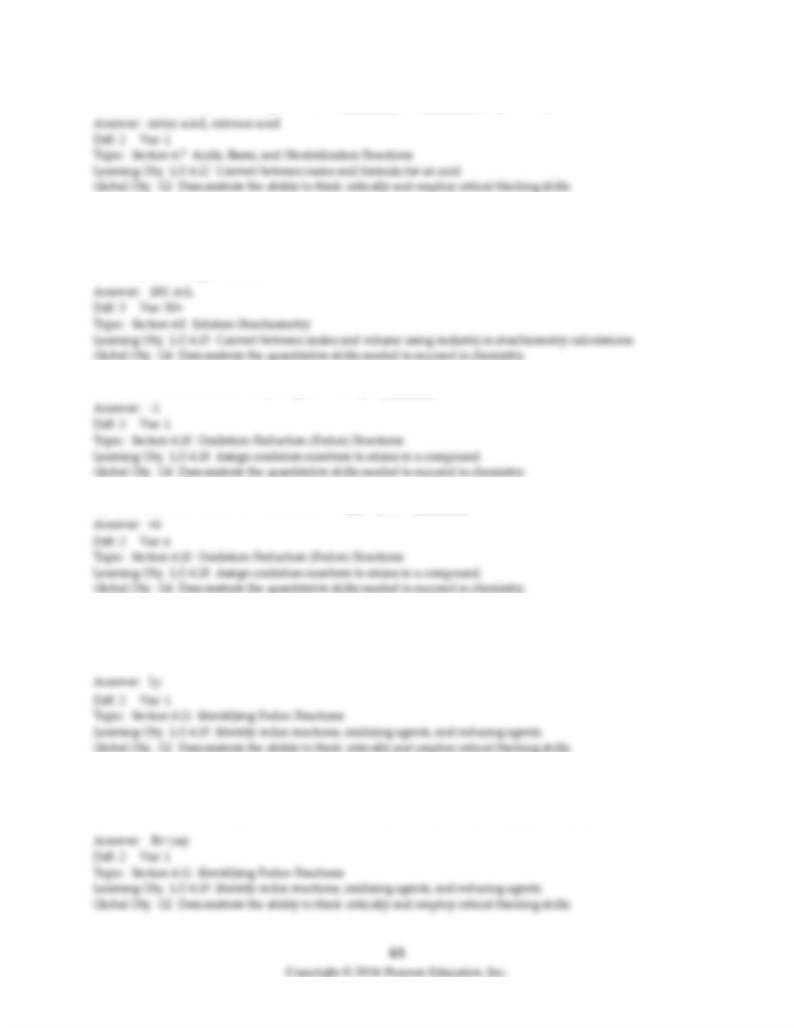
18) The acids HNO3 and HNO2 are named ________ and ________, respectively.
19) The number of milliliters of 0.250 M HCl required to react with 100.0 mL of 0.450 M NaOH in the
reaction shown below is ________.
HCl + NaOH → H2O + NaCl
20) The oxidation number of hydrogen in CaH2 is ________.
21) The oxidation number of chromium in Ag2Cr2O7 is ________.
22) The substance is undergoing oxidation in the reaction below is ________.
2 S2O32-(aq) + I3-(aq) → S4O62-(aq) + 3 I-(aq)
23) In the following reaction, the reducing agent is ________.
2 MnO4-(aq) + 10 Br-(aq) + 16 H+(aq) → 2 Mn2+(aq) +5 Br2(aq) + 8 H2O(aq)
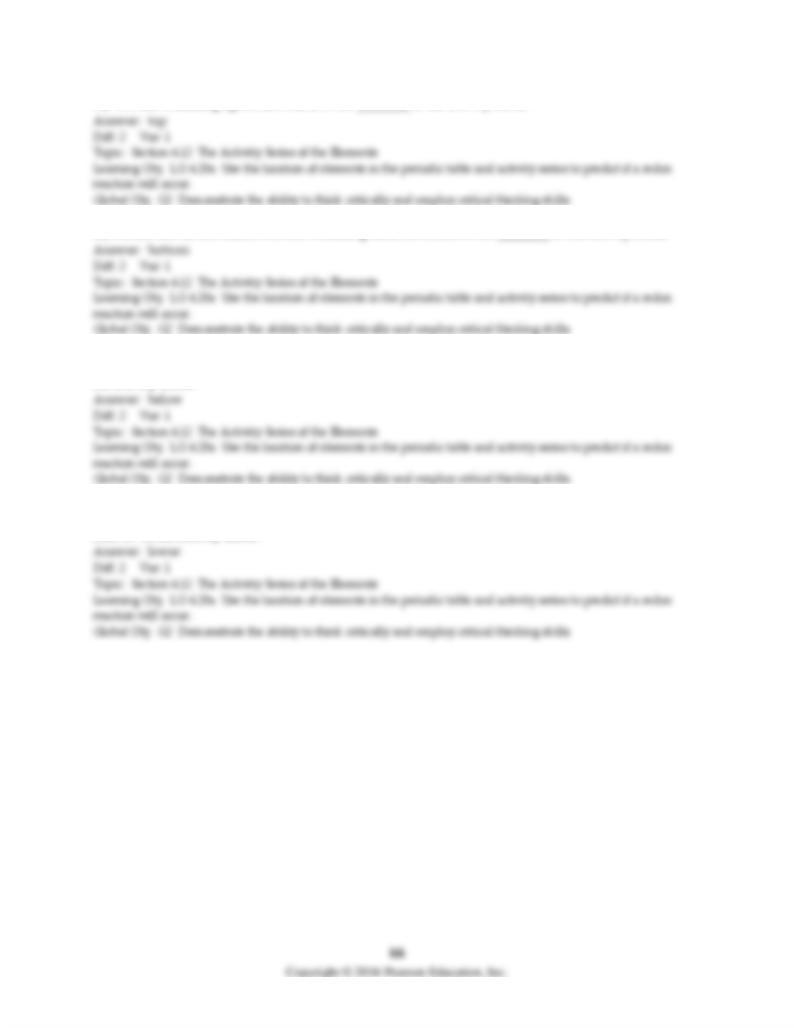
24) The best oxidizing agents are found at the ________ of the activity series.
25) Metals that do not dissolve in non-oxidizing acids are found at the ________ of the activity series.
26) Metals that do not react with hydrochloric acid to produce hydrogen gas are found ________ H2 in
the activity series.
27) The reaction Cu(s) + 2 HCl(aq) → CuCl2(aq) + H2(g) is predicted not to occur because Cu is ________
than H+ in the activity series.